Equipment Roundup - Part 2
01/12/10 07:43 Filed in: Anchoring | Propulsion
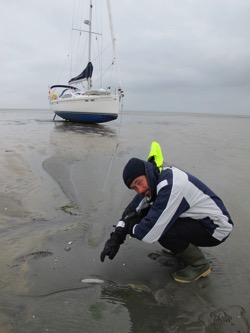
Rocna 33Kg Anchor - Excellent - In my opinion this is the best all-round anchor, working well in sand, mud and soft mud. It sets quickly and holds very well. It also sets well in most grass and weed although the Delta might outperform it there since it doesn’t have the ring on top. Basically most modern anchors will work well if they are big enough. This is one thing I really admire about Rocna - they recommend a realistic size anchor for a cruising boat. For our 49 footer we could have used either a 33kg or 40kg version of the Rocna according to their website. Other anchor manufacturers recommend much lighter versions but in the very small print they are talking about using it up to just 30 knots wind. I think similar anchor shapes like the Manson and the Spade might also perform well in similar sizes. But would need to be much bigger than they recommend. For instance, Spade Anchors recommend the 77ld (similar to our 73lb Rocna) would be sufficient for a 75 foot boat?! Rocna suggest their 73lb for 40-50 footers (66 feet only if the boat was an ultralight racer weighing less than 10t). Rocna tables - For real life cruising when you occasionally wake up at 3am in gusts of 40 knots you want to know you have been conservative in sizing your anchor! Here I inspect our Rocna at low tide after winds of 30-35 blew all night. Not budging!
Yanmar 4JH4 Engine - 56hp - Excellent!! - Very nice performing engine - well engineered. Affordable parts (versus certain other makes... not to name names). The instrument panel is abit cheesy but all my experience with the engine is positive.
3 bladed fixed prop - oops... not good - it certainly pushes the boat along nicely under power but a real drag under sail. We hadn’t ordered a feathering/folding prop for the 49 for this past summer cruise and really missed it!! The Variprop we had on the 42 was excellent. Will probably go for another on the 49 for this season. Definitely we need to change from the fixed prop. It is certainly the best way to improve performance on any sailboat. We’ll go at least 1/2 knot faster under sail and I think closer to 1 knot in some situations.
Comments
Equipment Roundup
Having the new boat has been a great opportunity to get that new gear I always thought would be a good idea. I thought I would do a round-up of the equipment now that we have had a year to try it out. So here goes... in no particular order
Electric heads - Tecma - they have been brilliant! No breakages and no servicing required yet. I had thoroughly disliked our Jabsco heads previously. They needed constant maintenance, required way too much pumping to operate and frequently seemed to malfunction. There had to be a better way and the Tecma electric head is perfect for us. I have ordered a spares kit for them (not cheap!) but it is well worth it. I know purists will suggest an electric toilet is somehow “not proper” but if all fails we always have a bucket...
Forced Air Heating System - Espar - Wonderful! Nothing beats coming down below to a toasty warm boat after a cold/wet sailing day. The Espar has just worked flawlessly. It does have a small and slightly bizarre control panel that does theoretically allow it to be turned on and off at preprogrammed intervals but we haven’t used that option. We just turn it on and set it for 1-3 hours as needed. Great!
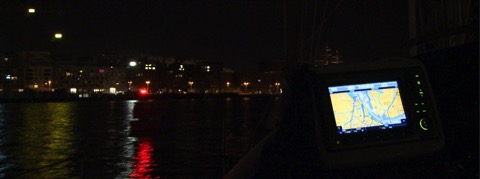
Plotters - Raymarine’s new E90Wide X 2 units. These are the new touchscreen hybrids that have full control either with touch or buttons. The plotter is the heart of the boats navigation system and the E-wides are excellent. I really like the touch screen ability including a popup onscreen keyboard to name waypoints etc. These units also come with a huge number of built-in charts - another big savings over the old style. But adding the Navionics charts is great also since it gives you harbour info, tides and currents plus aerial shots of harbours if you don’t have a cruising guide. The picture above was shot leaving Amsterdam at night. The plotter up on deck working perfectly as usual. Bright enough to be easily read on the brightest day, it also goes right down for night use. With the radar and AIS overlaid we can see ships that might otherwise be hard to spot against the lights of the city.
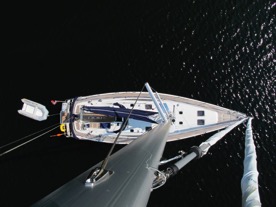 Electric winch - Lewmar conversion - This was a lifesaver! We sailed a couple of months then added the electric winch so we can compare before/after. The 49 means everything is 20-30% bigger and raising the mainsail was a tough slog. On the 42 I pulled the main up to just 1 meter from the masthead then put it on the winch. With the bigger 49-footer the same effort means I can pull it with 4-5 meters left to go. So I have to winch the sail 4-5 times as far. The electric winch handles it easily. It also meant we had no trouble going up the mast. Sheryl can easily pull me up and that meant we could get more shots from the masthead!! Depending on your boat, an electric winch could make sense. Even just adding one as I did could change your sailing a lot.
Electric winch - Lewmar conversion - This was a lifesaver! We sailed a couple of months then added the electric winch so we can compare before/after. The 49 means everything is 20-30% bigger and raising the mainsail was a tough slog. On the 42 I pulled the main up to just 1 meter from the masthead then put it on the winch. With the bigger 49-footer the same effort means I can pull it with 4-5 meters left to go. So I have to winch the sail 4-5 times as far. The electric winch handles it easily. It also meant we had no trouble going up the mast. Sheryl can easily pull me up and that meant we could get more shots from the masthead!! Depending on your boat, an electric winch could make sense. Even just adding one as I did could change your sailing a lot.
LED Lighting - Imtra - A revelation! Finally LED lighting that works and lasts! We can now afford to turn on any lights we light. On the darker winter days we can run all the lights we want. Using perhaps 1/4 the power of the old lights. The lights are designed from the ground up as LED lights rather than adding replacement bulbs to conventional fixtures. This means they can build in a nice heat sink for the power circuits. I am sure they will last for many years giving us a cozy well lit boat!
...
This is just the start... now I am rolling I want to go through more tomorrow - anchor, engine etc...
Electric heads - Tecma - they have been brilliant! No breakages and no servicing required yet. I had thoroughly disliked our Jabsco heads previously. They needed constant maintenance, required way too much pumping to operate and frequently seemed to malfunction. There had to be a better way and the Tecma electric head is perfect for us. I have ordered a spares kit for them (not cheap!) but it is well worth it. I know purists will suggest an electric toilet is somehow “not proper” but if all fails we always have a bucket...
Forced Air Heating System - Espar - Wonderful! Nothing beats coming down below to a toasty warm boat after a cold/wet sailing day. The Espar has just worked flawlessly. It does have a small and slightly bizarre control panel that does theoretically allow it to be turned on and off at preprogrammed intervals but we haven’t used that option. We just turn it on and set it for 1-3 hours as needed. Great!

Plotters - Raymarine’s new E90Wide X 2 units. These are the new touchscreen hybrids that have full control either with touch or buttons. The plotter is the heart of the boats navigation system and the E-wides are excellent. I really like the touch screen ability including a popup onscreen keyboard to name waypoints etc. These units also come with a huge number of built-in charts - another big savings over the old style. But adding the Navionics charts is great also since it gives you harbour info, tides and currents plus aerial shots of harbours if you don’t have a cruising guide. The picture above was shot leaving Amsterdam at night. The plotter up on deck working perfectly as usual. Bright enough to be easily read on the brightest day, it also goes right down for night use. With the radar and AIS overlaid we can see ships that might otherwise be hard to spot against the lights of the city.

LED Lighting - Imtra - A revelation! Finally LED lighting that works and lasts! We can now afford to turn on any lights we light. On the darker winter days we can run all the lights we want. Using perhaps 1/4 the power of the old lights. The lights are designed from the ground up as LED lights rather than adding replacement bulbs to conventional fixtures. This means they can build in a nice heat sink for the power circuits. I am sure they will last for many years giving us a cozy well lit boat!
...
This is just the start... now I am rolling I want to go through more tomorrow - anchor, engine etc...
Planning your trip
22/11/10 07:36 Filed in: Planning | Life Aboard
One of the best things about our “job” (sailing and telling about it on television) is that we get to hear from others who have been inspired to set off on journeys of their own!
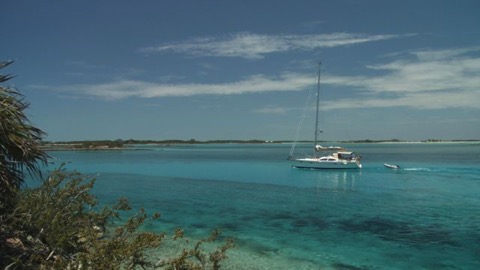
Many of the notes we get are from people planning a 1-2 year (or more) trip down to warmer climes. We are happy to think we have helped a number of these people to start off on their big adventure! And often it is just a bit of extra confidence to know that regular people are making the trips on a regular basis. Often one partner has some doubts and a bit of reassurance is all that’s needed. Can we stay in touch with family and friends? Are there Pirates? How do you deal with storms?
Certainly it is easier than ever now to get information to plan your voyage. Weather info is getting better and better! Storms can be avoided in many instances thanks to vastly improved access to forecasts at sea. Although pirates seem to be getting more airtime than ever, the truth is they are mainly confined to specific areas which are mostly avoidable. As to being in touch with family and friends... cruising has never been better than right now. There are a bewildering array of options for being in touch that didn’t exist even 15 years ago. Wifi, email cell phone and video Skype, sat phone, blogging sms, you can Tweet your family with up to the minute news!! (ok maybe thats being TOO in touch)
One of the nicest comments we have heard about our television show “Distant Shores” is from other cruisers who have used it to reassure family and friends about the cruising lifestyle. It isn’t all storms, high seas adventure and pirates. There are great people in foreign ports, interesting cultures to be discovered and new friends waiting to be made!
We hope to see you out their!
Cheers,
Paul
SUPER DUPER Christmas Special
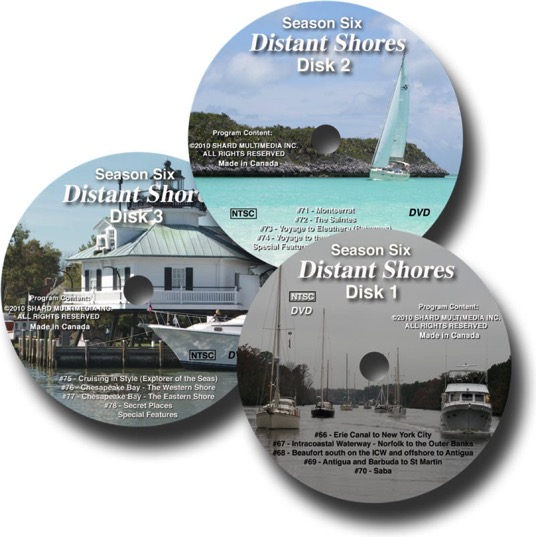
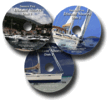
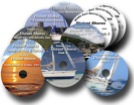
Buy the Special Super Pack including ALL DISTANT SHORES episodes - Season 1 though 6 for just US$120 / C$124 (PAL $135) - 14 DVDs in all

Many of the notes we get are from people planning a 1-2 year (or more) trip down to warmer climes. We are happy to think we have helped a number of these people to start off on their big adventure! And often it is just a bit of extra confidence to know that regular people are making the trips on a regular basis. Often one partner has some doubts and a bit of reassurance is all that’s needed. Can we stay in touch with family and friends? Are there Pirates? How do you deal with storms?
Certainly it is easier than ever now to get information to plan your voyage. Weather info is getting better and better! Storms can be avoided in many instances thanks to vastly improved access to forecasts at sea. Although pirates seem to be getting more airtime than ever, the truth is they are mainly confined to specific areas which are mostly avoidable. As to being in touch with family and friends... cruising has never been better than right now. There are a bewildering array of options for being in touch that didn’t exist even 15 years ago. Wifi, email cell phone and video Skype, sat phone, blogging sms, you can Tweet your family with up to the minute news!! (ok maybe thats being TOO in touch)
One of the nicest comments we have heard about our television show “Distant Shores” is from other cruisers who have used it to reassure family and friends about the cruising lifestyle. It isn’t all storms, high seas adventure and pirates. There are great people in foreign ports, interesting cultures to be discovered and new friends waiting to be made!
We hope to see you out their!
Cheers,
Paul
SUPER DUPER Christmas Special



Buy the Special Super Pack including ALL DISTANT SHORES episodes - Season 1 though 6 for just US$120 / C$124 (PAL $135) - 14 DVDs in all
Sailing South for the Winter
17/11/10 08:40 Filed in: Planning
We have just returned to Canada our UK-Baltic 8-month cruise. Distant Shores II is safely back in England where she will stay ashore until we return in April. We are back in the studio in Canada working on the new shows for our broadcasters (WealthTV in the USA and Travel Channel in Europe).
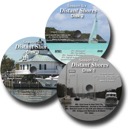 The past 2 weeks I have been working in the studio on our latest DVD series - Distant Shores Season Six - Chesapeake Bay, ICW and Leeward Islands. Re-watching the shows on going through the Erie Canal to New York, the Intracoastal Waterway, and the Caribbean... makes me want to go.
The past 2 weeks I have been working in the studio on our latest DVD series - Distant Shores Season Six - Chesapeake Bay, ICW and Leeward Islands. Re-watching the shows on going through the Erie Canal to New York, the Intracoastal Waterway, and the Caribbean... makes me want to go.
November weather always makes me think of heading south! I know that the years we did this trip south were busy with preparations and planning, and dreaming of the voyage ahead. Getting ready for the adventure is part of the journey itself!
We have done the complete trip south from Canada to Florida/Bahamas 3 times since 1989, most recently in 2008/9 filming for Distant Shores. For anyone living in the US NorthEast or Eastern Canada, this trip is a fun way to live the tropical dream - heading south for a warm winter!!
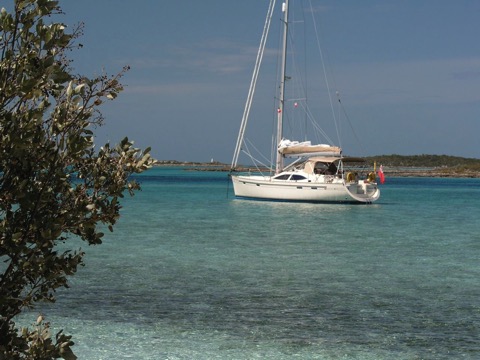
If you are planning to do this trip then this season of 13 half-hour shows will help you see what the trip is like, and whet your appetite for the adventure ahead. And if you are going to do the trip... drop us a note, we like to think our programs can help inform and/or inspire viewers to do the trip themselves!

Click here to order the new Season Six DVD set, or as part of the new Super Pack - Season 1-6

November weather always makes me think of heading south! I know that the years we did this trip south were busy with preparations and planning, and dreaming of the voyage ahead. Getting ready for the adventure is part of the journey itself!
We have done the complete trip south from Canada to Florida/Bahamas 3 times since 1989, most recently in 2008/9 filming for Distant Shores. For anyone living in the US NorthEast or Eastern Canada, this trip is a fun way to live the tropical dream - heading south for a warm winter!!

If you are planning to do this trip then this season of 13 half-hour shows will help you see what the trip is like, and whet your appetite for the adventure ahead. And if you are going to do the trip... drop us a note, we like to think our programs can help inform and/or inspire viewers to do the trip themselves!

Click here to order the new Season Six DVD set, or as part of the new Super Pack - Season 1-6
Holland Canals & Islands
Having just completed the Dutch “Standing-Mast Route” I thought I would give you an overview and some images from the trip. Much more fun and lovely than we had expected!!
Stand Mast Route as it is called in the Netherlands allows bigish boats to cross Holland from the German border to the North Sea coast with the mast up. This compares to most European canals that have lower clearances, the Stand Mast Route allows 30meter heights, so our 20.5m (67 feet) is fine.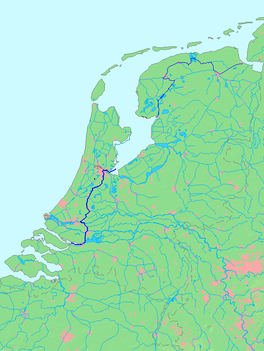 See Wikipedia page or search “staande mastroute” or “standing mast route” for more info.
See Wikipedia page or search “staande mastroute” or “standing mast route” for more info.
We started on the Ems river on the right but wanted to visit one last Frisian Island so hopped up north to do that first. Then we joined the Staande Mastroute at its most northerly where it is close to the Waddensee. This meant a tricky patch of navigating through the shallow tidal sands en route to Schiermonnikoog.
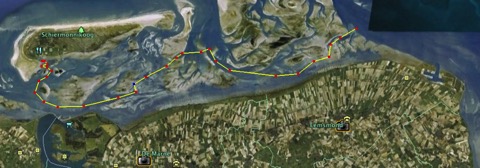
This channel only allows passage for shallow boats and we saw only the lovely Dutch sailing barges plus a few of the special shallow ferries that take people out to the islands. This chart is “not to be used for navigation” :-)
Here is the dock at Schiermonnikoog and the entry channel 2 hours after we came through it (on a falling tide!!) The sticks are the “official” channel marks, called withies.
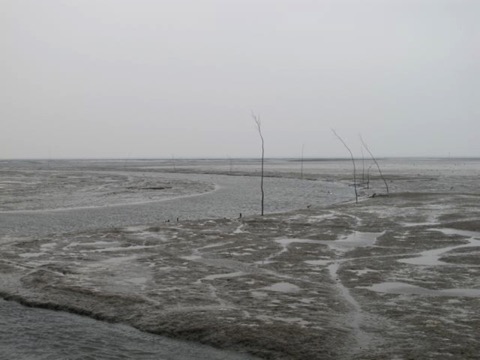
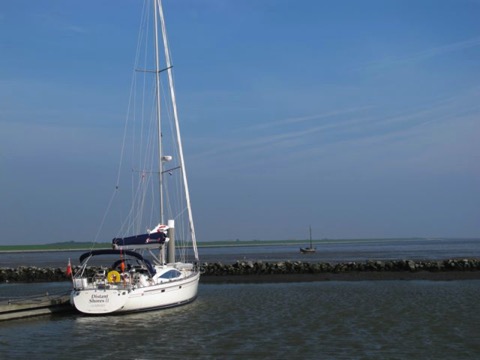
From here we entered locked into the Dutch Canals didn’t have to worry about tides for a couple of weeks.
Here are a few pix from the gorgeous Dutch canals. We tied up each night in another VERY CUTE and tidy Dutch town.
If you choose to do this very nice route...
Here are some shots
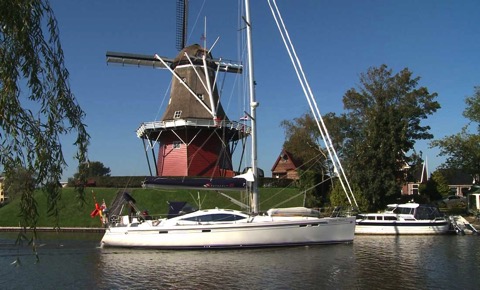
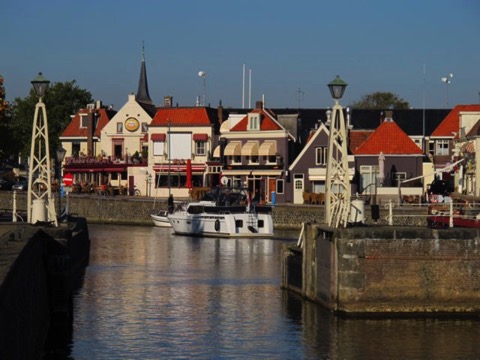
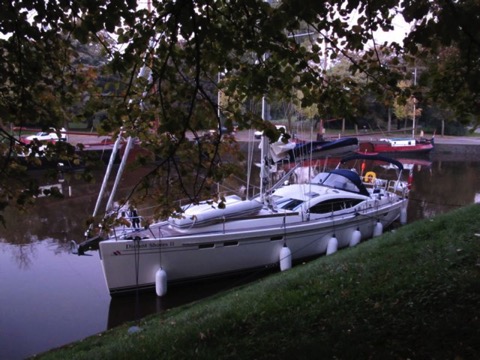
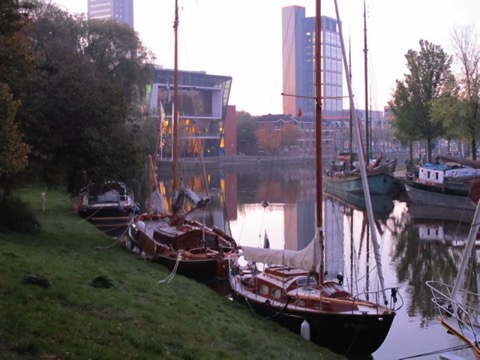

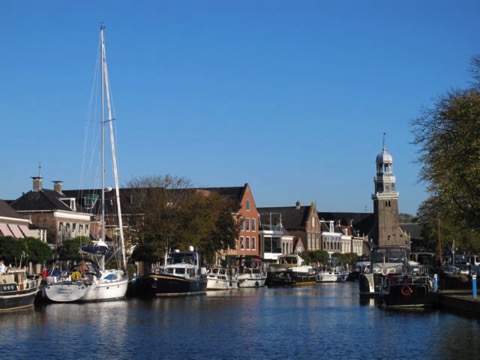
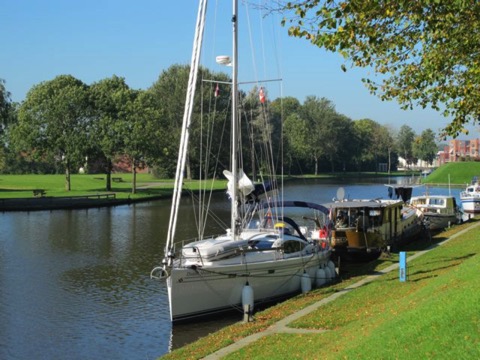
Stand Mast Route as it is called in the Netherlands allows bigish boats to cross Holland from the German border to the North Sea coast with the mast up. This compares to most European canals that have lower clearances, the Stand Mast Route allows 30meter heights, so our 20.5m (67 feet) is fine.

We started on the Ems river on the right but wanted to visit one last Frisian Island so hopped up north to do that first. Then we joined the Staande Mastroute at its most northerly where it is close to the Waddensee. This meant a tricky patch of navigating through the shallow tidal sands en route to Schiermonnikoog.

This channel only allows passage for shallow boats and we saw only the lovely Dutch sailing barges plus a few of the special shallow ferries that take people out to the islands. This chart is “not to be used for navigation” :-)
Here is the dock at Schiermonnikoog and the entry channel 2 hours after we came through it (on a falling tide!!) The sticks are the “official” channel marks, called withies.


From here we entered locked into the Dutch Canals didn’t have to worry about tides for a couple of weeks.
Here are a few pix from the gorgeous Dutch canals. We tied up each night in another VERY CUTE and tidy Dutch town.
If you choose to do this very nice route...
- mast height must be less than 30 meters (a power wire crosses)
- depths seem fine up to perhaps 6 feet
- take your time and enjoy!
Here are some shots







Weather - Passage Planning
13/10/10 02:12 Filed in: Storms
The past few weeks we have been heading back south from Sweden... making bigger jumps and pushing to get back south. Up in Sweden everyone had quit sailing and boats are all put away for the winter. So it was time! It got me thinking about planning for passages and how we learn about the weather and conditions for a new sailing area. It seems we are always sailing in a new place and have to learn new rules and weather conditions.

Traditionally we have “Pilot Charts” that summarize the winds, waves currents and typical sailing routes for various areas of the world over the last number of years. In the old days they were all you had to gauge what conditions to expect. But they are really just averages of past years. So they will only give you a probability of average winds. So for us planning a return to Britain from Sweden we could see we would have many days of southwest winds. In advance I used this to plan our schedule. Knowing we would often have headwinds I built in a number of delay days for our passage plan. We also planned to return across Sweden via the Gota canal since we could always do that regardless of headwinds.
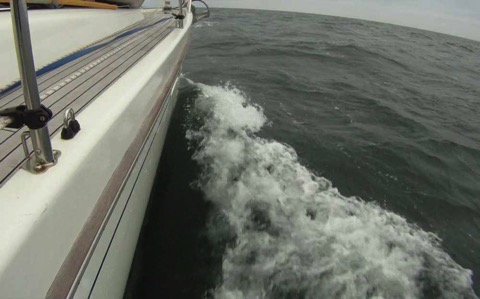
But as the time gets closer it is possible to use some of the amazing resources of the Web to get better information. Watching up to 10 days in advance we can see if we should hurry off now with a minimum weather window or hold on for improving conditions.
Here in Europe I have a few nice sites that give long range predictions...
http://www.windfinder.com/forecasts/ <-- 7 day winds animation
http://www.ecmwf.int/products/forecasts/ <-- 10 day pressure predictions
But looking at the pilot charts and the current forecasts isn’t going to make you into a weather expert (not immediately anyway!). My biggest problem is that we are always new to an area and don’t have “local knowledge”. Here in the North Sea area winds often prevail from the southwest - but does that mean 2 out of 3 days the wind is from that direction or for 10 days followed by 5 days from somewhere else? I have found studying the weather patterns from previous years can help with this. Pilot charts are a statistical summary, but now with the internet you can go back and study in detail what happened in past years.
I take a few hours and look around to see what the weather looked like in past years. From our crossing of the Bay of Biscay I found some amazing sites going back years with detailed information - here is a specific site with sea buoys in a variety of places.
http://www.tutiempo.net/en/Climate/ENVIRONM_BUOY
Got to run - off across the IJsselmeer toward Amsterdam!

Traditionally we have “Pilot Charts” that summarize the winds, waves currents and typical sailing routes for various areas of the world over the last number of years. In the old days they were all you had to gauge what conditions to expect. But they are really just averages of past years. So they will only give you a probability of average winds. So for us planning a return to Britain from Sweden we could see we would have many days of southwest winds. In advance I used this to plan our schedule. Knowing we would often have headwinds I built in a number of delay days for our passage plan. We also planned to return across Sweden via the Gota canal since we could always do that regardless of headwinds.

But as the time gets closer it is possible to use some of the amazing resources of the Web to get better information. Watching up to 10 days in advance we can see if we should hurry off now with a minimum weather window or hold on for improving conditions.
Here in Europe I have a few nice sites that give long range predictions...
http://www.windfinder.com/forecasts/ <-- 7 day winds animation
http://www.ecmwf.int/products/forecasts/ <-- 10 day pressure predictions
But looking at the pilot charts and the current forecasts isn’t going to make you into a weather expert (not immediately anyway!). My biggest problem is that we are always new to an area and don’t have “local knowledge”. Here in the North Sea area winds often prevail from the southwest - but does that mean 2 out of 3 days the wind is from that direction or for 10 days followed by 5 days from somewhere else? I have found studying the weather patterns from previous years can help with this. Pilot charts are a statistical summary, but now with the internet you can go back and study in detail what happened in past years.
I take a few hours and look around to see what the weather looked like in past years. From our crossing of the Bay of Biscay I found some amazing sites going back years with detailed information - here is a specific site with sea buoys in a variety of places.
http://www.tutiempo.net/en/Climate/ENVIRONM_BUOY
Got to run - off across the IJsselmeer toward Amsterdam!
Locks - Through the Gota Canal
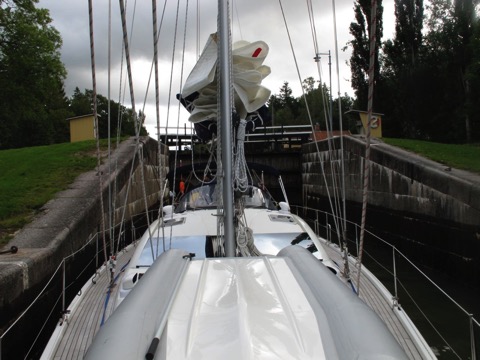
Recommendations for transiting the Gota Canal in Sweden always state you need at least 3 people on a boat to lock through. One will stay at the helm, one will deal with lines and one will get off to thread lines through the rings used to secure the boat in this old system.
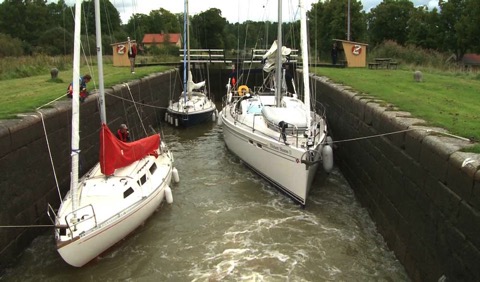
The Gota Canal was built in 1810-20 and most of the locks are original. Maximum dimensions of boats are... Width: 7 m; length: 30 m; depth 2.82 m; height: 22 m. I think if your boat really is 7 meters wide you wouldn’t have room for fenders - possibly not even a thick coat of paint!! Distant Shores II is 4.3 meters wide and we were fine (with our big fenders) but it sure feels snug especially going between the many bridges. I was prepared for the 58 locks to feel snug, but not thinking of bridges. Coming up to a 7 meter wide bridge in a crosswind needs careful lining-up.
On our first day in the locks there were a number of smaller boats, plus the lovely Deodar - 23 meters long and 6 meters beam. They definitely were more than snug edging through the bridges. Here they are maneuvering into a lock and trying to keep the fenders from rolling out. By the end of 3 days they had a few scratches on the hull.
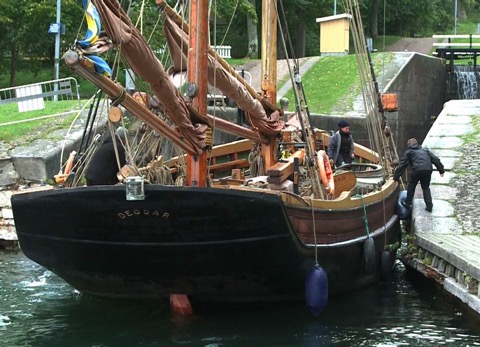
We have 4 very large fenders plus 2 slightly smaller (but still large) fenders and hoped this would be fine. In reality I think we should have bought 2-3 more medium fenders. We also set up a nice long 2by4 board to protect the fenders as they slide up the rough lock walls. 8-10 feet long and drill a hole through the board so the supporting ropes won’t chafe. We find the board saves the fenders which can otherwise get quite torn up.
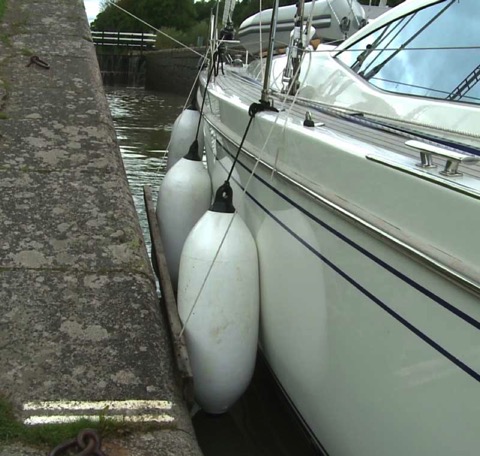
Note the rig we use to deal with the lines. The bow line is led from the forward cleat all the way aft to the cockpit and put on a winch. I have done the same with the stern line. This way I can control bow and stern tightening both lines as we go up.
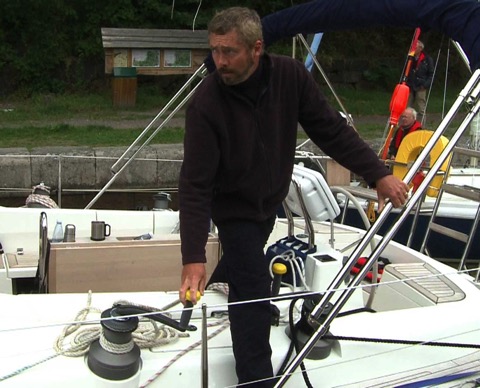
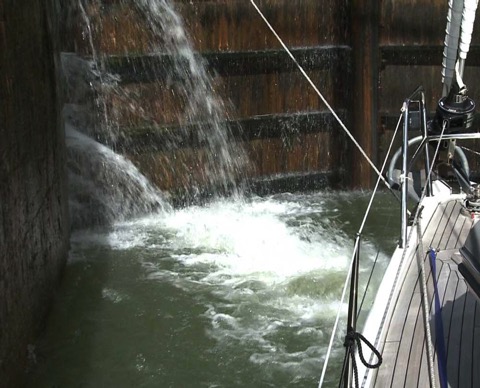
Yesterday evening we finished the Gota Canal - 5 days and 58 locks. Lots of fun and lovely scenery! I would recommend a few more fenders - even just temporary ones if you can’t keep them after doing the locks. Good insurance!!
Here is a shot of sailing off across Lake Vattern. One of the big advantages of the Gota Canal is that it allows 22 meters of mast clearance. No low bridges like on the Trent Severn, Erie Canal and most other canal systems. So we don’t have to worry about taking the mast down - plus we can enjoy a nice sail on Sweden’s lakes!
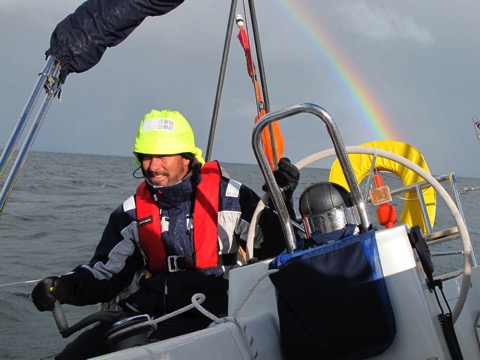
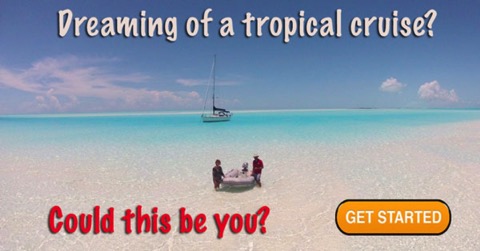
Sir Robin & Self-Sufficiency
15/09/10 02:11
This past weekend Sheryl & I were at the Southampton Boat Show and had the great privilege to meet Sir Robin Knox-Johnston. Robin has been a big hero of mine for decades! He is best known for being the first person to sail alone and non-stop around the world in the Golden Globe race in 1968-69. More recently he did it again at the age of 68 and in between he has done lots more for the sailing world (See Robins Homepage).
It has been some years now since we’d read his excellent book “A World of My Own” and since we knew we were going to meet Sir Robin at the Southerly Dinner we decided to reread it. What a treat! If you haven’t read the book I highly recommend you get a copy. The story is exciting and a great read, but I also found it a great insight into the attitude that will succeed in offshore voyaging “I can do this! There is a way!”
Robin took a wooden 32-footer around the world in 312 days and during that time practically everything broke! “His water tanks were polluted, a storm put his radio out of action, his self-steering gear disintegrated, his main boom collapsed, his tiller sheered but he refused to give up” (from the back cover of “A World of My Own”). In fact this severely understates the number of problems he had!!
From fashioning a new gooseneck, rebuilding the generator, radio and practically everything else on board, to diving over and adding strips to seal major hull leaks he shows the value of being resourceful. But more than that he shows the value of a positive attitude and refusal to give up.
The next time I am faced with a problem I can’t see how to solve I will remember that attitude and ask myself how Sir Robin would have looked at it. It is alright to curse at it but then get down to work. And afterwards it’s OK to “go below and check the level of the whisky bottle”...
Paul
p.s. This picture is down below on the HMS Warrior in Portsmouth. What a fantastic venue to hear sea stories told by Sir Robin Knox-Johnston!
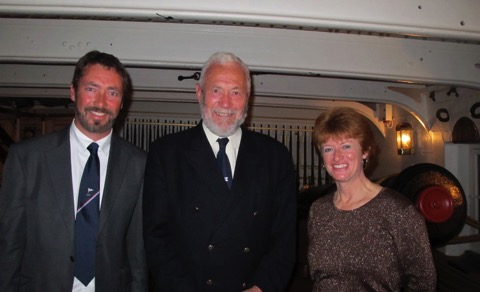
It has been some years now since we’d read his excellent book “A World of My Own” and since we knew we were going to meet Sir Robin at the Southerly Dinner we decided to reread it. What a treat! If you haven’t read the book I highly recommend you get a copy. The story is exciting and a great read, but I also found it a great insight into the attitude that will succeed in offshore voyaging “I can do this! There is a way!”
Robin took a wooden 32-footer around the world in 312 days and during that time practically everything broke! “His water tanks were polluted, a storm put his radio out of action, his self-steering gear disintegrated, his main boom collapsed, his tiller sheered but he refused to give up” (from the back cover of “A World of My Own”). In fact this severely understates the number of problems he had!!
From fashioning a new gooseneck, rebuilding the generator, radio and practically everything else on board, to diving over and adding strips to seal major hull leaks he shows the value of being resourceful. But more than that he shows the value of a positive attitude and refusal to give up.
The next time I am faced with a problem I can’t see how to solve I will remember that attitude and ask myself how Sir Robin would have looked at it. It is alright to curse at it but then get down to work. And afterwards it’s OK to “go below and check the level of the whisky bottle”...
Paul
p.s. This picture is down below on the HMS Warrior in Portsmouth. What a fantastic venue to hear sea stories told by Sir Robin Knox-Johnston!

Force 8 Sailing
01/08/10 02:22 Filed in: Storms | Offshore sailing
Last weekend the Baltic had one of its summer gales! Much of our time here has been in quite light winds but every few weeks a front passes over and the winds get up. In this case it was even higher than the predicted 35 knots. We were sailing along the south coast of Sweden, and the wind was forecast to come from the northwest.
We were tied up in a secure harbour on the Sunday morning. The wind was already blowing in gusts over 30 knots and it looked like nobody was going to go out sailing. The weather service on the VHF was forecasting a gale warning. But I saw an opportunity to give the new boat a decent test in strong winds! Looking at the chart I saw a harbour just 25 miles down the coast which would mean we could sail with an offshore wind on the beam. So we wouldn’t be in big seas and would have a chance to try out the boat in strong winds for just a few hours. Perfect...
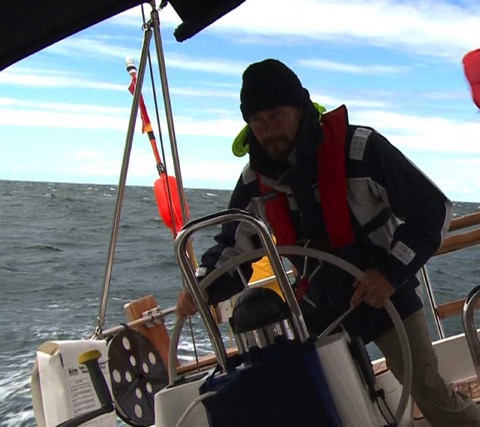
We battened everything down, untied, and headed out from the tiny harbor of Gislövs Läge. I had planned to sail with a double reefed main and reefed job, but there seemed to be more wind than forecast so we just partially unfurled the jib (no mainsail). The wind gusted over 30 and we scooted along at more than 8 knots - hitting 9. As soon as we got further out the wind stabilized a bit at 25-30 with gusts 35-40. But I had been right that we would have a nice comfortable ride since the wind was offshore - we never saw waves bigger than 1 meter.
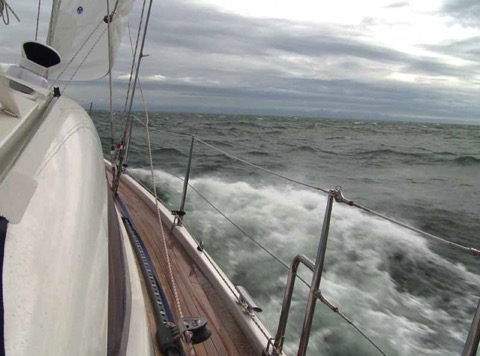
The image doesn’t show it so well but you can see the bow wave being blown off in spray in the gusts. But also you can see the waves weren’t high.
We averaged over 8.2 for the 3 hours it took to reach Ystad. The boat was perfectly balanced and easy to steer. Dry decks and a comfy ride! The longer boat at 49 feet really does make for more comfort. During the whole sail we saw one other boat - a 40 footer close-hauled and motor-sailing west (the other way). Incredibly he was towing his dinghy - which naturally had flipped upside down. He must have been having a bad time since he just ignored it and kept on going with it upside down.
The only other boat we saw was just as we approached Ystad - the local Search and Rescue cutter came out and zoomed past in a cloud of spray. Winds gusted here at 40 knots - occasionally higher. We sailed right up to the harbour at Ystad and came in to find a dock. Thankfully the winds were lower close in shore since the harbour was quite full. But friendly cruisers grabbed lines as we came in to raft up. Praise to our big fenders and bow thruster so maneuvering in these tight conditions was no problem.
As a postscript to this story I found a news item the next day that 4 sailors had been rescued by Polish SAR in that same gale just over a hundred miles to the southeast.
We had a great sail however. It felt good to have tried the boat out in these conditions when it would have been easy to just stay put. Now we have more experience with how our new boat handles in strong winds so if we’re ever caught out in bad weather on a passage we now know that she handles winds up to 35-40 knots quite nicely with just a reefed jib. We filmed this in Episode 86 Distant Shores downloadable here in Vimeo - click on Episode 86
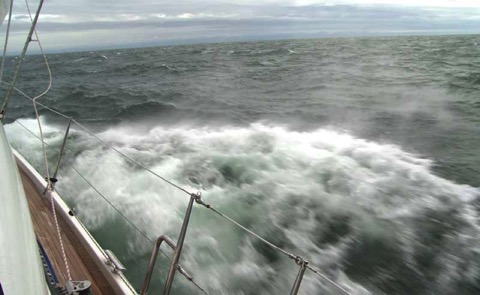
For more on stormy sailing check out our other blogs on Storms
Plan your passages around the world with us aboard Distant Shores
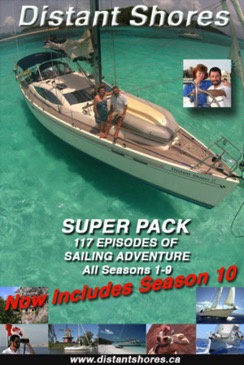
Order the Super Pack on DVD and get Season 1-10 Downloadable.
Order the Super Pack on Vimeo and we will send you the code for Season 10 as a bonus.
Sailing in a Gale
We were tied up in a secure harbour on the Sunday morning. The wind was already blowing in gusts over 30 knots and it looked like nobody was going to go out sailing. The weather service on the VHF was forecasting a gale warning. But I saw an opportunity to give the new boat a decent test in strong winds! Looking at the chart I saw a harbour just 25 miles down the coast which would mean we could sail with an offshore wind on the beam. So we wouldn’t be in big seas and would have a chance to try out the boat in strong winds for just a few hours. Perfect...

We battened everything down, untied, and headed out from the tiny harbor of Gislövs Läge. I had planned to sail with a double reefed main and reefed job, but there seemed to be more wind than forecast so we just partially unfurled the jib (no mainsail). The wind gusted over 30 and we scooted along at more than 8 knots - hitting 9. As soon as we got further out the wind stabilized a bit at 25-30 with gusts 35-40. But I had been right that we would have a nice comfortable ride since the wind was offshore - we never saw waves bigger than 1 meter.

The image doesn’t show it so well but you can see the bow wave being blown off in spray in the gusts. But also you can see the waves weren’t high.
We averaged over 8.2 for the 3 hours it took to reach Ystad. The boat was perfectly balanced and easy to steer. Dry decks and a comfy ride! The longer boat at 49 feet really does make for more comfort. During the whole sail we saw one other boat - a 40 footer close-hauled and motor-sailing west (the other way). Incredibly he was towing his dinghy - which naturally had flipped upside down. He must have been having a bad time since he just ignored it and kept on going with it upside down.
The only other boat we saw was just as we approached Ystad - the local Search and Rescue cutter came out and zoomed past in a cloud of spray. Winds gusted here at 40 knots - occasionally higher. We sailed right up to the harbour at Ystad and came in to find a dock. Thankfully the winds were lower close in shore since the harbour was quite full. But friendly cruisers grabbed lines as we came in to raft up. Praise to our big fenders and bow thruster so maneuvering in these tight conditions was no problem.
As a postscript to this story I found a news item the next day that 4 sailors had been rescued by Polish SAR in that same gale just over a hundred miles to the southeast.
We had a great sail however. It felt good to have tried the boat out in these conditions when it would have been easy to just stay put. Now we have more experience with how our new boat handles in strong winds so if we’re ever caught out in bad weather on a passage we now know that she handles winds up to 35-40 knots quite nicely with just a reefed jib. We filmed this in Episode 86 Distant Shores downloadable here in Vimeo - click on Episode 86

For more on stormy sailing check out our other blogs on Storms
Plan your passages around the world with us aboard Distant Shores

Order the Super Pack on DVD and get Season 1-10 Downloadable.
Order the Super Pack on Vimeo and we will send you the code for Season 10 as a bonus.
Dealing with Shipping - AIS Part 2
29/06/10 02:24 Filed in: AIS
3 years ago when we first got an AIS receiver we were SO happy that we could easily see and understand ships. The AIS receiver allowed us to see all ships within a 15-35 mile range AND to know their name and call sign so we could call them if we saw they would come close to us. Here is a typical view of the plotter showing ships as small triangles.
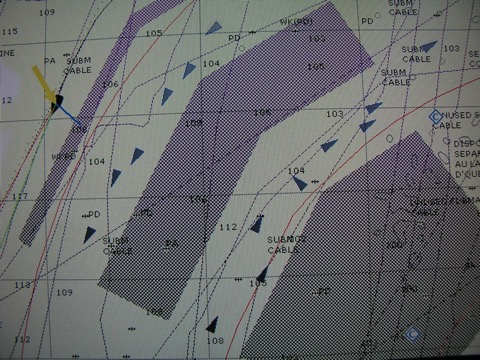
We are in the upper left corner with the yellow arrow indicating the wind, blue is line showing a small current/leeway.
The greyed lines are showing the shipping traffic separation scheme near France. With the AIS you can see the exact position of the shipping and instantly understand what they are doing. For instance, the ship in the top center of the screen appears to be heading for us. But he is obviously in the lanes so we know he will turn shortly and will not be a concern. And If he was we could just look at him for more information. AIS shows all kind of info including length, speed, name callsign etc. Here is a sample screen.
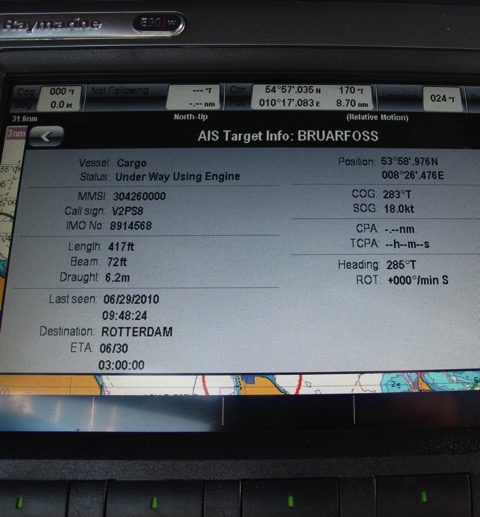
Note we even see the ship’s length, beam and draft. The CPA is “Closest point of Approach” and the TCPA is the time until we will reach that close point. In this case the ship is heading away from us so there are no number for CPA and TCPA.
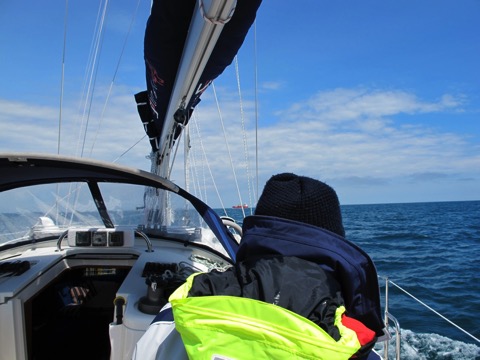
Keeping an eye on approaching ships as we cross the english channel to Guernsey in the Channel Islands.
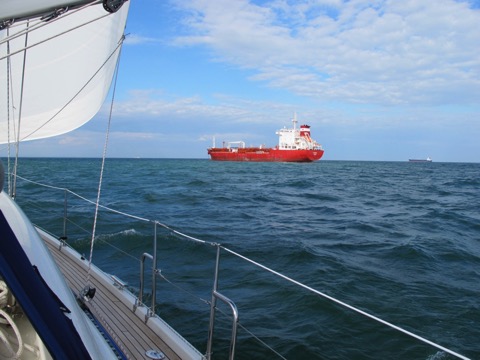
Should we alter course? Is there a risk here? No, this ship is anchored and we knew this miles in advance since the AIS showed their speed as 0.1 knot and the status as anchored!
AIS Class B for smaller boats
So what could be better than having an AIS receiver??
How about an AIS transmitter like the big ships have! That way ships can see us as well. They will get automatic alarms if we are going to come close to them. Although they should see us on their radar, this is a much more secure system and works without needing an operator. In conditions of reduced visibility they will know exactly where we are as well as our speed, name and callsign. This is called AIS Class B.
With Distant Shores II we have added one of the new Raymarine AIS transmitters. The newly designed AIS Class B Raymarine AIS500.
This is a very cleverly designed system and integrates amazingly into the Raymarine network. It uses the ships existing VHF antenna so it doesn’t need almost any additional wiring. And since it displays the shipping on the plotter it doesn’t need a separate monitor either. The AIS500 is just a small box that is hidden away, using very little power.
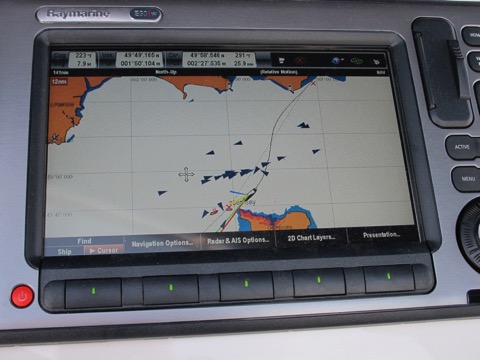
Now that we have had a couple of passages with the system I can report back that it is fantastic!! Crossing the English Channel to the Channel Islands I took this screenshot as we were crossing the shipping lanes near Guernsey. Busy! Similar as we were crossing the North Sea up to the Netherlands.
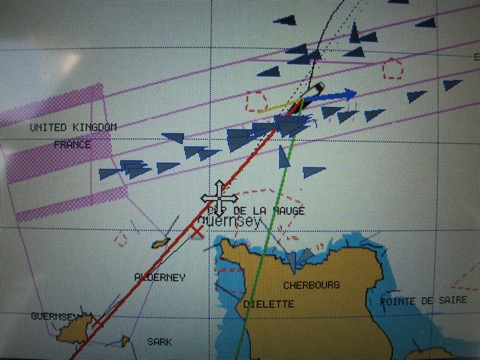
Now the ships see us as a target on their systems and are instantly alerted if we will come close. In practice we have found them to be happily swerving a bit to avoid us without us needing to call them in advance. Of course we also change course to avoid the ships, but now we are broadcasting AIS they will immediately see we have altered course and realize they don’t need to.
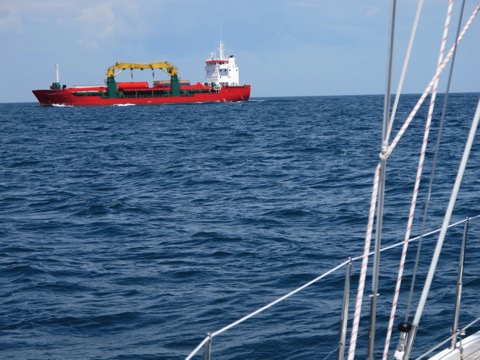
I cannot stress enough how the AIS system has reduced our worries on sea passages. Especially at night it can be difficult to deal with shipping. In the event there are many ships it used to be almost impossible to call the ship you were worried about since you didn’t know their name. Now with AIS you call the exact ship you are concerned about. And now our with AIS Class B transmitter they will know who it is so they could call us as well. Since AIS uses very little power and is not very expensive it seems like a very intelligent purchase for sailors who venture out to sea as we do. It is the best kind of insurance - the kind that reduces the risk of a problem in the first place!

We are in the upper left corner with the yellow arrow indicating the wind, blue is line showing a small current/leeway.
The greyed lines are showing the shipping traffic separation scheme near France. With the AIS you can see the exact position of the shipping and instantly understand what they are doing. For instance, the ship in the top center of the screen appears to be heading for us. But he is obviously in the lanes so we know he will turn shortly and will not be a concern. And If he was we could just look at him for more information. AIS shows all kind of info including length, speed, name callsign etc. Here is a sample screen.

Note we even see the ship’s length, beam and draft. The CPA is “Closest point of Approach” and the TCPA is the time until we will reach that close point. In this case the ship is heading away from us so there are no number for CPA and TCPA.

Keeping an eye on approaching ships as we cross the english channel to Guernsey in the Channel Islands.

Should we alter course? Is there a risk here? No, this ship is anchored and we knew this miles in advance since the AIS showed their speed as 0.1 knot and the status as anchored!
AIS Class B for smaller boats
So what could be better than having an AIS receiver??
How about an AIS transmitter like the big ships have! That way ships can see us as well. They will get automatic alarms if we are going to come close to them. Although they should see us on their radar, this is a much more secure system and works without needing an operator. In conditions of reduced visibility they will know exactly where we are as well as our speed, name and callsign. This is called AIS Class B.
With Distant Shores II we have added one of the new Raymarine AIS transmitters. The newly designed AIS Class B Raymarine AIS500.
This is a very cleverly designed system and integrates amazingly into the Raymarine network. It uses the ships existing VHF antenna so it doesn’t need almost any additional wiring. And since it displays the shipping on the plotter it doesn’t need a separate monitor either. The AIS500 is just a small box that is hidden away, using very little power.

Now that we have had a couple of passages with the system I can report back that it is fantastic!! Crossing the English Channel to the Channel Islands I took this screenshot as we were crossing the shipping lanes near Guernsey. Busy! Similar as we were crossing the North Sea up to the Netherlands.

Now the ships see us as a target on their systems and are instantly alerted if we will come close. In practice we have found them to be happily swerving a bit to avoid us without us needing to call them in advance. Of course we also change course to avoid the ships, but now we are broadcasting AIS they will immediately see we have altered course and realize they don’t need to.

I cannot stress enough how the AIS system has reduced our worries on sea passages. Especially at night it can be difficult to deal with shipping. In the event there are many ships it used to be almost impossible to call the ship you were worried about since you didn’t know their name. Now with AIS you call the exact ship you are concerned about. And now our with AIS Class B transmitter they will know who it is so they could call us as well. Since AIS uses very little power and is not very expensive it seems like a very intelligent purchase for sailors who venture out to sea as we do. It is the best kind of insurance - the kind that reduces the risk of a problem in the first place!
Electric Winch
17/06/10 01:27 Filed in: Rigging | Electrical
Why go electric?
I have often wondered about adding an electric winch. As boats get bigger, as we get a bit older, or just lazier, it might seem like a good idea. I also wonder if there are times I might not bother raising the main for just a shorter sail and just putting the jib out because its easy! I guess that means I am lazier ;-) Anyway with the new 49 footer it was time to think about the question again.
Raising the main on the 49 is just that much more work than the 42. With the 42 I could raise the sail to within 3 feet of the masthead and just winch it the last bit. The job is a tough one first thing in the morning (and honestly a bit much for Sheryl I think). When we were spec’ing out the 49 I wondered if we would need an electric halyard winch but decided to wait and see. The sail is 33% larger than the one on our 42 and I would guess roughly that much heavier.
Now that we have had the boat for a few months and sailed her in a variety of conditions we have found out just how much difference there is between the two. Without the winch I can pull the sail up just above the upper spreaders. That is a tough pull then there is still almost 20 feet left to winch. So it was definitely time to go for an electric halyard winch.
Adding the winch turned out to be a medium sized job in two main parts...
In this case the installation was much simpler since we were converting the existing Lewmar winch to power. All Lewmar winches sold in the last number of years are easily convertible using a standard conversion kit. So we would be using the same winch and just adding a new base plate, and motor assembly belowdecks.
Running the wire
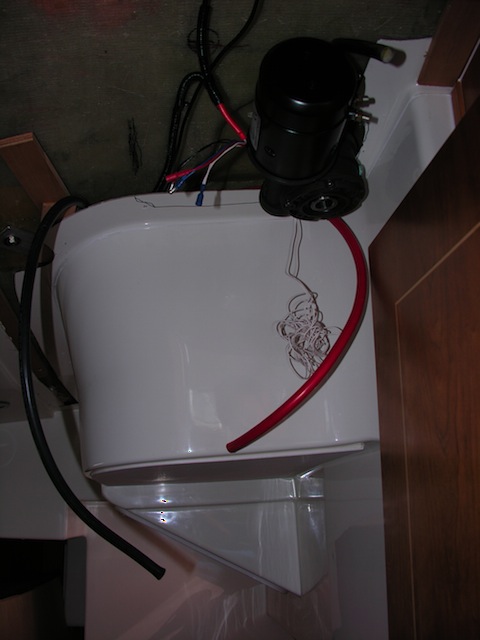
Heavy wiring installed ready to connect to winch
Installing the winch
In our case I was converting the halyard winch which is on the cabin top so we had to carefully consider where the motor would intrude the least into the cabin. The winch itself will have a new base plate and a gear shaft that allows the motor below to drive the winch. This requires a new large hole drilled in the deck. Always fun drilling a big hole in your new boat!!
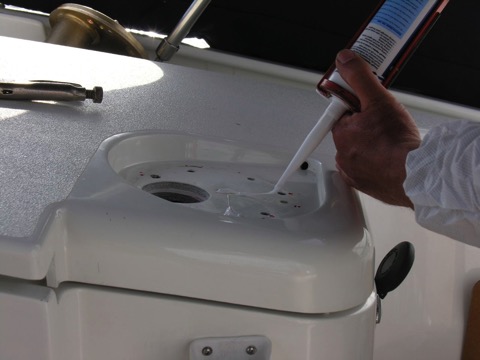
After final fitting the new base plate is set down with silicone.
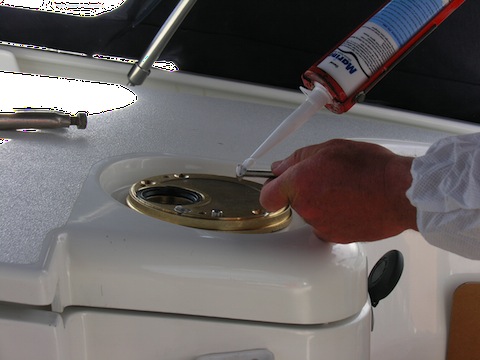
I mounted the switch under the winch checking so we could see the main while pushing the button.
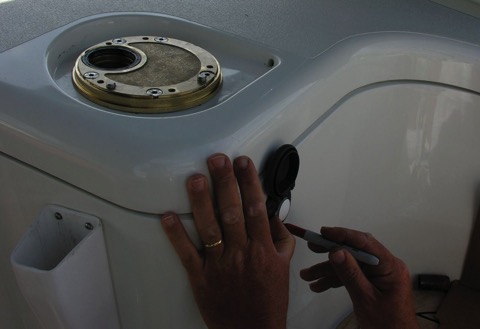
Using the winch
Our first outing with the new winch was for our 30 mile sail down the English Channel to Brighton. A mid afternoon departure was dictated by the tides so 1500 hours saw us heading into the wind in the Solent. Raising the main was a dream! What a pleasure to just push the button and watch the sail go up. On to Brighton, then Ramsgate, then across to Holland!
One useful technique we have seen on other boats is to use the halyard winch for other jobs as well. In our case we can also lead other lines to the electric winch. Our two forward furled sails also require a good healthy pull. They can be winched by the aft cockpit winches but it is a long chore in heavy wind. Now I can lead the furling line with just one turn around the cockpit winch then up to the electric winch. What a great advantage!! One electric winch doing quite a few of the heaviest winching jobs. It was certainly a conversion well worth doing.
I have often wondered about adding an electric winch. As boats get bigger, as we get a bit older, or just lazier, it might seem like a good idea. I also wonder if there are times I might not bother raising the main for just a shorter sail and just putting the jib out because its easy! I guess that means I am lazier ;-) Anyway with the new 49 footer it was time to think about the question again.
Raising the main on the 49 is just that much more work than the 42. With the 42 I could raise the sail to within 3 feet of the masthead and just winch it the last bit. The job is a tough one first thing in the morning (and honestly a bit much for Sheryl I think). When we were spec’ing out the 49 I wondered if we would need an electric halyard winch but decided to wait and see. The sail is 33% larger than the one on our 42 and I would guess roughly that much heavier.
Now that we have had the boat for a few months and sailed her in a variety of conditions we have found out just how much difference there is between the two. Without the winch I can pull the sail up just above the upper spreaders. That is a tough pull then there is still almost 20 feet left to winch. So it was definitely time to go for an electric halyard winch.
Adding the winch turned out to be a medium sized job in two main parts...
- running the heavy wire from the main battery bank to the winch
- installing the winch itself on deck
In this case the installation was much simpler since we were converting the existing Lewmar winch to power. All Lewmar winches sold in the last number of years are easily convertible using a standard conversion kit. So we would be using the same winch and just adding a new base plate, and motor assembly belowdecks.
Running the wire
- Electric winches use a lot of power so we used very heavy wire - 70mm2 or double-0 AWG.
- A 150Amp circuit breaker was used to connect it to the main distribution
- If you have any doubts about this kind of work it may be best to have a contractor help with the wiring (or do the whole install)

Heavy wiring installed ready to connect to winch
Installing the winch
In our case I was converting the halyard winch which is on the cabin top so we had to carefully consider where the motor would intrude the least into the cabin. The winch itself will have a new base plate and a gear shaft that allows the motor below to drive the winch. This requires a new large hole drilled in the deck. Always fun drilling a big hole in your new boat!!

After final fitting the new base plate is set down with silicone.

I mounted the switch under the winch checking so we could see the main while pushing the button.

Using the winch
Our first outing with the new winch was for our 30 mile sail down the English Channel to Brighton. A mid afternoon departure was dictated by the tides so 1500 hours saw us heading into the wind in the Solent. Raising the main was a dream! What a pleasure to just push the button and watch the sail go up. On to Brighton, then Ramsgate, then across to Holland!
One useful technique we have seen on other boats is to use the halyard winch for other jobs as well. In our case we can also lead other lines to the electric winch. Our two forward furled sails also require a good healthy pull. They can be winched by the aft cockpit winches but it is a long chore in heavy wind. Now I can lead the furling line with just one turn around the cockpit winch then up to the electric winch. What a great advantage!! One electric winch doing quite a few of the heaviest winching jobs. It was certainly a conversion well worth doing.
Dealing with Shipping
28/05/10 02:26 Filed in: Offshore sailing | AIS
Crossing the English Channel means crossing one of the busiest area of shipping in the world, and there is also the possibility of fog or reduced visibility to make it more thrilling! Just what you need when facing 4-5 ships heading your way all at once... Shipping used to be a real worry and night passages were filled with bearings and calculations and worry as we observed their lights on the horizon and tried to figure out their intentions.
AIS to the rescue! This crossing was another good example of why an AIS unit is an excellent investment for anyone venturing out into busy waters. We left the dock in Chichester at 0100 and by 0130 had cleared the mouth of the harbour into the English Channel. Our plotter on deck showed our position as well as the fact that we had more-or-less got the expected current. It also showed all the ships in a good 20 mile radius since the AIS receiver passes that info on to the Raymarine plotters.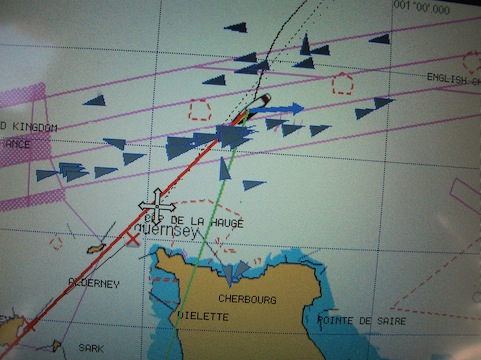
We shot this image a bit later as we were closer to France. The blue arrow on our boat indicates the current, the red line our heading and the green line where we are actually going with the effect of the current. You can see there are quite a few ships just ahead as we approach the east-bound shipping. When we zoom in we see most of the ships will pass easily ahead or behind us since the AIS also calculates the “closest point of approach” and the time until that point for each ship. Best of all we know the names of the ships so we can call them if we think there is a problem! In this case none were close enough to warrant a call. The stress reduction from having a plotter on deck with AIS info on it is truly amazing!
Now for the first time we have an AIS transponder meaning we are also transmitting so the ships can also see us on their display. Even better!
We arrived in Guernsey in the early afternoon after a calm and stress free crossing. Then on to Jersey where we saw the highest tides we have ever seen!! We arrived just after low water and waited outside the marina.
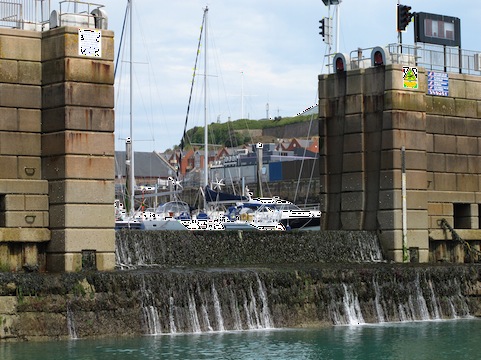
We are looking at the only entrance to the marina. This wall is the “sill” and is almost 3 meters high blocking our way in. When the tide rises it will cover the sill and allow us in. It will actually cover the sill by more than 5 meters! The tide this day was 10 meters - over 30 feet!!
I took this from the quayside - basically what will be water level when the tide is up. It is quite amazing sailing in these waters since the whole landscape changes so much with the dramatic rise and fall of the tides.
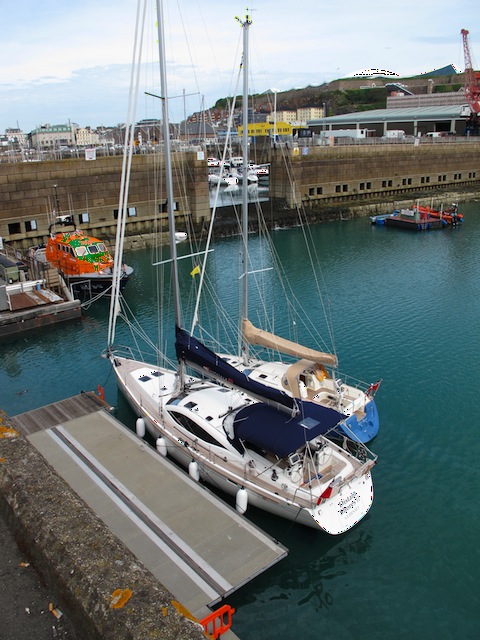
AIS to the rescue! This crossing was another good example of why an AIS unit is an excellent investment for anyone venturing out into busy waters. We left the dock in Chichester at 0100 and by 0130 had cleared the mouth of the harbour into the English Channel. Our plotter on deck showed our position as well as the fact that we had more-or-less got the expected current. It also showed all the ships in a good 20 mile radius since the AIS receiver passes that info on to the Raymarine plotters.

We shot this image a bit later as we were closer to France. The blue arrow on our boat indicates the current, the red line our heading and the green line where we are actually going with the effect of the current. You can see there are quite a few ships just ahead as we approach the east-bound shipping. When we zoom in we see most of the ships will pass easily ahead or behind us since the AIS also calculates the “closest point of approach” and the time until that point for each ship. Best of all we know the names of the ships so we can call them if we think there is a problem! In this case none were close enough to warrant a call. The stress reduction from having a plotter on deck with AIS info on it is truly amazing!
Now for the first time we have an AIS transponder meaning we are also transmitting so the ships can also see us on their display. Even better!
We arrived in Guernsey in the early afternoon after a calm and stress free crossing. Then on to Jersey where we saw the highest tides we have ever seen!! We arrived just after low water and waited outside the marina.

We are looking at the only entrance to the marina. This wall is the “sill” and is almost 3 meters high blocking our way in. When the tide rises it will cover the sill and allow us in. It will actually cover the sill by more than 5 meters! The tide this day was 10 meters - over 30 feet!!
I took this from the quayside - basically what will be water level when the tide is up. It is quite amazing sailing in these waters since the whole landscape changes so much with the dramatic rise and fall of the tides.

Sailing a Bigger Boat
 We have had a few weeks of test sailing now. The spring here in south England has been lovely and we have been able to get out on a number of excursions. Although we are still getting the feel of the new boat - we have a number of observations on how she handles. It has been great to have this time with her without making any big passages!
We have had a few weeks of test sailing now. The spring here in south England has been lovely and we have been able to get out on a number of excursions. Although we are still getting the feel of the new boat - we have a number of observations on how she handles. It has been great to have this time with her without making any big passages!The Bigger Boat
She is bigger inside and has more storage but doesn’t feel that much bigger to handle. I was wondering if the extra size would make it more difficult to maneuver especially in port and in close quarters. But in fact she feels quite similar to the Southerly 42. Although she is 7 feet longer she is just 6 inches wider and the same height. So she feels quite like the 42. Spinning her around in a marina requires me to take the extra length into account but we have had no problems. She handles very well in reverse, and add the excellent bow thruster and we have been fine. We have now wiggled our way into a number of tight slips. (We do have some nice big fenders and thats a good thing with any boat I think)
- practice makes perfect (or at least better)
- try out a new boat away from the dock
- get the feel of her in cross winds, how fast she turns, stops starts, which way the prop kicks etc
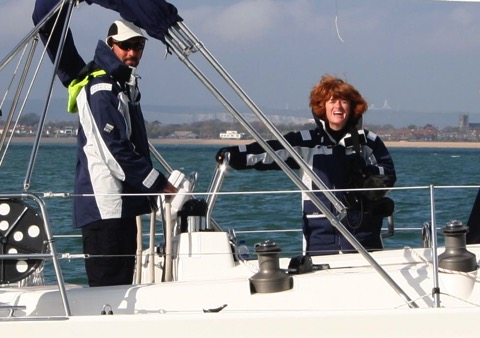
Sheryl having way too much fun!! (Photo by Yvette Jordan, SY M’LADY)
Bigger Stronger Faster
Of course one of the big advantages of a longer boat is a longer waterline which (on similar boats) should equal higher speeds. We have found this to be the case. The 49 can make 8 knots under power and so far hit 9 under sail. I know she can do more!
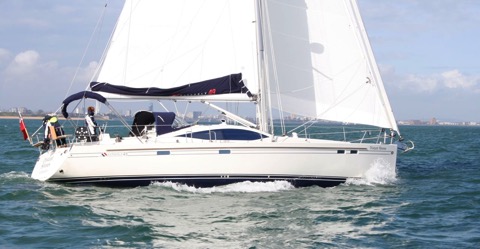
Distant Shores II sailing in the Solent (Photo by Yvette Jordan, SY M’LADY)
Comfortable Motion
The longer waterline also means less pitching and a smoother motion. We have not yet been in big seas with her but at least in moderate seas she shows the waterline length plus extremely deep keel makes for a very steady ride. (she draws 10 feet!!) Motoring out the Chichester Harbour entrance with swell against the out-flowing tide she cruised right through. Next to us were a contessa 26 and another 30 footer. The two smaller waterline boats were pitching quite a lot - showing their keel and burying their bows. A 42 footer was coming along as well and they were more similar to us - cutting through with minimal pitching. Waterline pays big dividends in comfort!
Sailing Like a Dinghy!
The day that really put my mind at ease about the bigger boat... we took out two local friends who are top-class dinghy sailors. Elizabeth and Mimie have sailed in Chichester Harbour all their lives and know every inch of the place. (They have plenty of experience cruising around the world in keel boats as well). It was a breezy day and we had the self-tacker and one reef in the main. I let them take the boat as I filmed. You can see the grins as they steered Distant Shores II around the harbour!
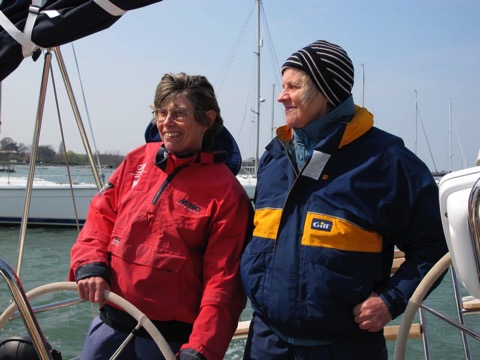
You can also see how close we are to the other boats. Their verdict was she handles great!! And to top off a perfect day we took her up to the head of the creek at high tide and then at low tide she was beached right in front of the pub!! The Crown and Anchor for dinner!
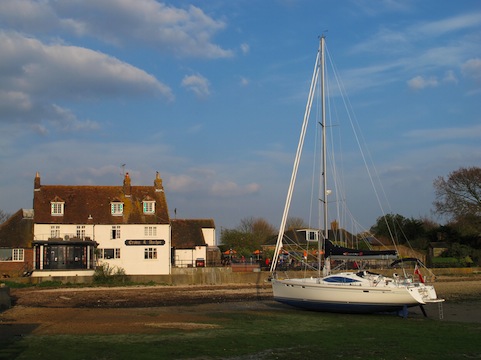
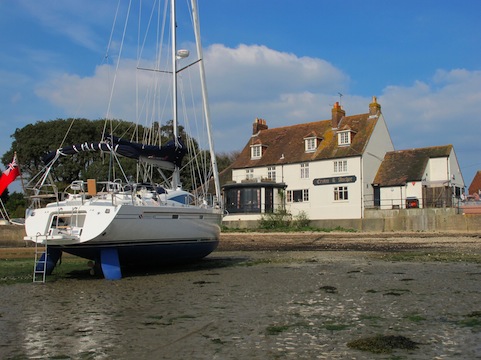
We sailed most of the way up to here at high tide.
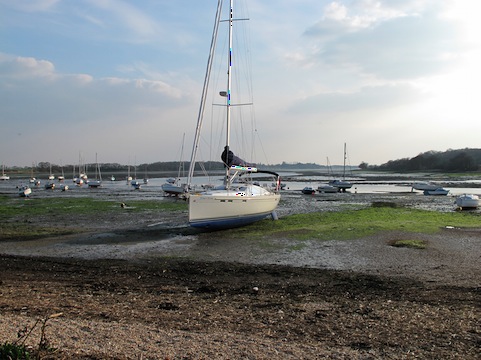
With the tide gone there is just a shallow creek left.
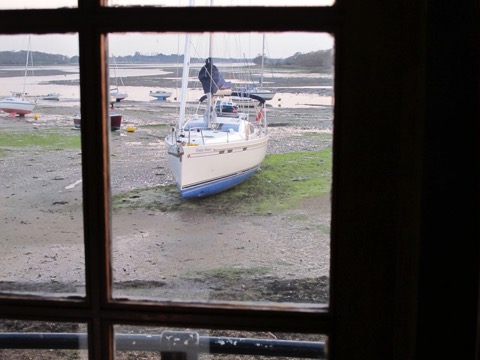
Heres the view from our table in the Crown and Anchor
Plan your passages around the world with us aboard Distant Shores

Order the Super Pack on DVD and get Season 1-10 Downloadable.
Radar in Hi-Def and Digital
10/04/10 06:38 Filed in: Radar
Leaving Portsmouth Harbour onboard Raymarine’s test boat.
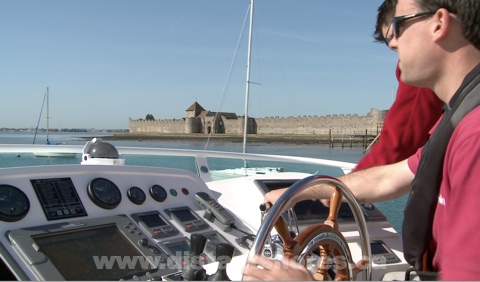
Yesterday we got a chance to go out on Raymarine’s amazing test and product development boat in Portsmouth Harbour on the Solent. The “Raymariner” is a 42 foot Hardy made here in the UK and it must have more electronics aboard than any other boat less than a hundred feet. I counted six radar arrays, 8 wind indicators and 14 GPS receivers on deck.

The boat has 7 (seven!!) complete autopilot systems! Yesterday was one of the first sunny spring days here. We were out for about 3 hours and got a chance to see the new HD radar technology in action. The area that would normally be the saloon on this boat has been purpose-built as a testing lab with desks that can patch into any of the sensors or systems. Using one of the new E-Wide series of Raymarine plotters (hybrid touch screens) we were able to compare various radar scanners operating in a real envirionment at sea. First we saw a large “open array” scanner, of course with excellent definition. I don’t have enough experience with the larger radars to compare but the images of the surrounding marks and coastline were very good. Stunning really!
But now they have HD Digital Radar. What does this really mean?
Lets take Digital Radar first. Traditional radar scanners have had very little of the working circuitry up in the radar itself. A huge thick cable runs from the display set up to the radome. But with digital radar, most of the functionality is moved up to the scanner. This has a number of advantages. The cable is much smaller saving quite a lot of weight aloft. It can talk to any display you have. We have 2 screens in the cockpit and previously that would mean the radar would have been run from one of them. So you would always need that on switched on to have radar. Now either display can run the radar. And I understand that digital radar makes a better image since the signal is interpreted right up in the scanner as it is received rather than travelling down the long wires to the display. Less signal loss.
HD - High Definition Radar - This sounds like just a buzz-word - can radar be “hi-def”? Well radar is really about definition. Defining a target by bouncing a signal pulse off it. Varying the pulse length and power allow you to get better definition, and measuring how strongly the signal comes back as well as how long it took to return (which means how far away it is)
With HD Radar the power of the modern computer is put to use tweaking the outgoing signal, and analyzing the returned pulse. Interpreting and analyzing means the radar can display an image that allows us to recognize the features we are interested in. The unit will tune itself and reduce sea clutter - even adapting to the different conditions. Below the menu shows easy setup to match conditions - “Buoy Mode, Harbour Mode, Offshore Mode and even “Bird Mode” to detect flocks of birds that might indicate good fishing!
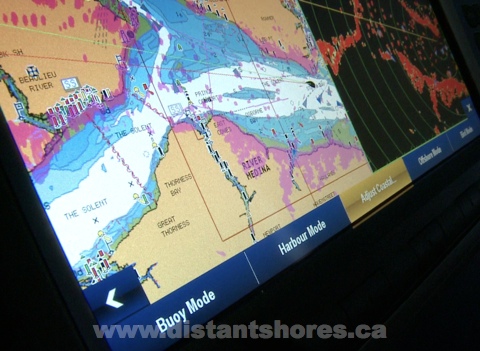
We have had 2 previous Raymarine radars, both 18 inch radomes. I was interested to see how the smaller radome would benefit from the HD Digital technology. I asked to see an image with the smaller radome as that is what most sailboats use - fitting either an 18 or 24 inch scanner in a dome to avoid tangling rigging in a spinning open array scanner. The image looked very detailed and clear to me! One of the big improvements seemed to be the reduced amount of clutter and less tuning needed. The automatic modes combined with overlaying the image on the chart makes an image that is easily recognizable to someone who isn’t a radar expert. As most of us sail short-handed (without a dedicated navigator on board) then having an easy to use radar is a great asset.
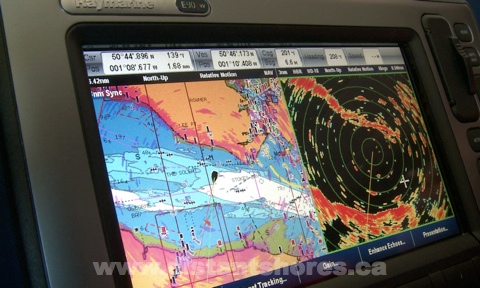
Radar is still one of the best upgrades you can do to increase safety and reduce stress especially at night and in reduced visibility. Here are my radar hints...

Yesterday we got a chance to go out on Raymarine’s amazing test and product development boat in Portsmouth Harbour on the Solent. The “Raymariner” is a 42 foot Hardy made here in the UK and it must have more electronics aboard than any other boat less than a hundred feet. I counted six radar arrays, 8 wind indicators and 14 GPS receivers on deck.

The boat has 7 (seven!!) complete autopilot systems! Yesterday was one of the first sunny spring days here. We were out for about 3 hours and got a chance to see the new HD radar technology in action. The area that would normally be the saloon on this boat has been purpose-built as a testing lab with desks that can patch into any of the sensors or systems. Using one of the new E-Wide series of Raymarine plotters (hybrid touch screens) we were able to compare various radar scanners operating in a real envirionment at sea. First we saw a large “open array” scanner, of course with excellent definition. I don’t have enough experience with the larger radars to compare but the images of the surrounding marks and coastline were very good. Stunning really!
But now they have HD Digital Radar. What does this really mean?
Lets take Digital Radar first. Traditional radar scanners have had very little of the working circuitry up in the radar itself. A huge thick cable runs from the display set up to the radome. But with digital radar, most of the functionality is moved up to the scanner. This has a number of advantages. The cable is much smaller saving quite a lot of weight aloft. It can talk to any display you have. We have 2 screens in the cockpit and previously that would mean the radar would have been run from one of them. So you would always need that on switched on to have radar. Now either display can run the radar. And I understand that digital radar makes a better image since the signal is interpreted right up in the scanner as it is received rather than travelling down the long wires to the display. Less signal loss.
HD - High Definition Radar - This sounds like just a buzz-word - can radar be “hi-def”? Well radar is really about definition. Defining a target by bouncing a signal pulse off it. Varying the pulse length and power allow you to get better definition, and measuring how strongly the signal comes back as well as how long it took to return (which means how far away it is)
With HD Radar the power of the modern computer is put to use tweaking the outgoing signal, and analyzing the returned pulse. Interpreting and analyzing means the radar can display an image that allows us to recognize the features we are interested in. The unit will tune itself and reduce sea clutter - even adapting to the different conditions. Below the menu shows easy setup to match conditions - “Buoy Mode, Harbour Mode, Offshore Mode and even “Bird Mode” to detect flocks of birds that might indicate good fishing!

We have had 2 previous Raymarine radars, both 18 inch radomes. I was interested to see how the smaller radome would benefit from the HD Digital technology. I asked to see an image with the smaller radome as that is what most sailboats use - fitting either an 18 or 24 inch scanner in a dome to avoid tangling rigging in a spinning open array scanner. The image looked very detailed and clear to me! One of the big improvements seemed to be the reduced amount of clutter and less tuning needed. The automatic modes combined with overlaying the image on the chart makes an image that is easily recognizable to someone who isn’t a radar expert. As most of us sail short-handed (without a dedicated navigator on board) then having an easy to use radar is a great asset.

Radar is still one of the best upgrades you can do to increase safety and reduce stress especially at night and in reduced visibility. Here are my radar hints...
- Display should be mounted so it is visible from the helm so the skipper can make quick decisions
- Practice with it on nice days when you can see what you are doing and compare real world to the radar display
- Make sure the unit can be dimmed down enough to be used at night without ruining your night vision. Raymarine does this nicely and also has a night palette changing to darker colours.Try out the overlay mode where the radar image is synchorized and drawn on top of the chart (as above left) This is my favourite mode.
- Get the first mate involved as well. Anyone nervous of sailing at night can find reassurance in “seeing” whats around with radar
- Add the AIS display on the radar overlay as well. Then ships show up nicely on the image too.
Down in the Mud
02/04/10 13:06 Filed in: Shoal draft
Our first time to put the new 49 on the ground - or in this case the mud. This is the immensely cute town of Bosham (pronounced bozzam) with its’ 1000 year old church down by the quayside. We came in at the noon high tide and stayed until the next noon. Tides here are much higher than we are used to at up to 5.2 meters! At low tide the whole of Bosham is surrounded by mud flats. All the sea is missing!
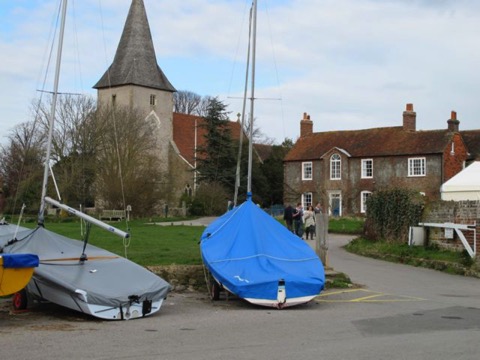
Here is the scene by 4-5 in the afternoon. All the water is gone and we have sunk down onto the mud. We were careful to tie so we could fall without straining our mooring lines. Long lines are good here. In this case we didn’t fall very far since the we landed on the mud - although the tide fell 4 meters we only fell a bit less than 2 so it was easier to tie!
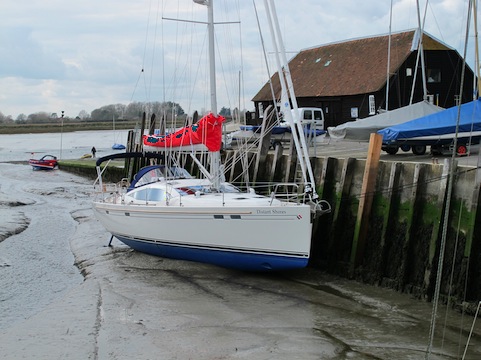
If you want to do work on the bottom you can use the drying grid they have installed here. The boat behind us is a 42 footer with over 6 foot draft. They had just a 1 hour window where the tide was high enough to allow them to come in. Then they tied up to the quay and the tide ran out. This meant a 3-4 hour period when they could get down and work on the bottom before the tide came back in. Bargain haulout!
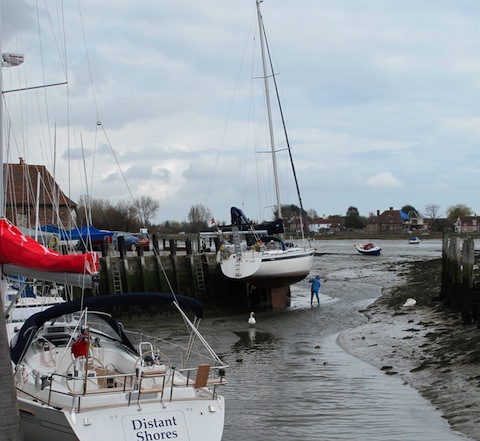
Note their boat is leaning slightly toward the quay. This is important so she just rests against the quay and her fenders. They hung a bucket off the end of the boom swung out over the quay and moved a few other heavy items that side. If you don’t do this you might end up falling away from the quay and placing tremendous strain on the docklines (or worse - falling right over!!)
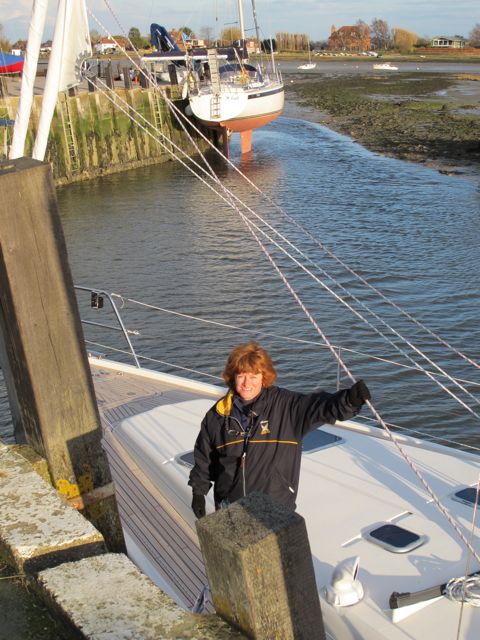
How-to Hints for drying out

Here is the scene by 4-5 in the afternoon. All the water is gone and we have sunk down onto the mud. We were careful to tie so we could fall without straining our mooring lines. Long lines are good here. In this case we didn’t fall very far since the we landed on the mud - although the tide fell 4 meters we only fell a bit less than 2 so it was easier to tie!

If you want to do work on the bottom you can use the drying grid they have installed here. The boat behind us is a 42 footer with over 6 foot draft. They had just a 1 hour window where the tide was high enough to allow them to come in. Then they tied up to the quay and the tide ran out. This meant a 3-4 hour period when they could get down and work on the bottom before the tide came back in. Bargain haulout!

Note their boat is leaning slightly toward the quay. This is important so she just rests against the quay and her fenders. They hung a bucket off the end of the boom swung out over the quay and moved a few other heavy items that side. If you don’t do this you might end up falling away from the quay and placing tremendous strain on the docklines (or worse - falling right over!!)

How-to Hints for drying out
- Check in advance that the area is going to be ok. If you have a keel boat you probably need a purpose-built drying grid since it needs a solid base to stand on and walk around underneath to work.The harbourmaster will have more info and recommendations. In our case we just need to find out if there is anything we don’t want to settle down onto.
- Tie up to account for the tides.
- Check that future tides will allow you to get off again! Read over the tables carefully
- Close the thruhulls before settling down on the mud. Especially intakes such as the engine, and head water intakes if these will be in the mud. We don’t want mud forced up into them. Remember to open them before motoring off :-)
- If you plan to stay more than 1 tide you might check it out the second time you settle down to the ground incase something has changed. This is especially important if you are a keelboat drying on the grid since you need to make certain you will rest against the quay properly.
Wiring - getting a handle on it!
02/04/10 12:34 Filed in: Electrical
With any new boat comes the process of familiarization with her systems. In this case the electrics are based on a distributed power system.
Engineer Ian installed the whole system (in fact all the mechanical systems in the boat) and he came on board yesterday. I got him to show me around the system a little. Ian does excellent work - he did all the mechanical and electrical work on the 42 as well.
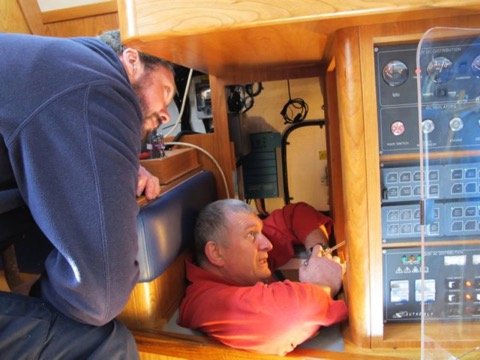
The work he does is very well thought out and very neat and tidy. As I start installing a few things I will try to keep to his high standards.
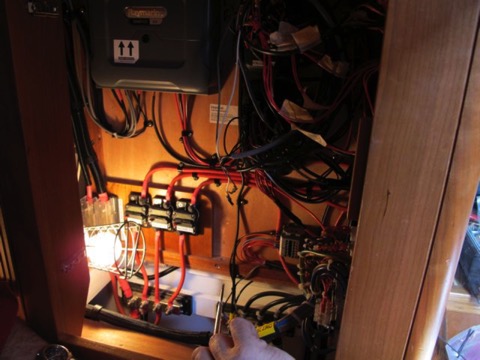
One thing you see in this picture is just how “uncrowded” it is behind the main electrical panel. This is because the distributed electrical system means only items installed near this area will be wired to here. Other items will be connected to “nodes” near that part of the boat. There are nodes in the forward cabin, saloon, galley, nav station (shown here) and aft. There really is much less wiring this way. On the lower left of this picture there are 3 square black boxes. They are the circuit breakers feeding three nearby “nodes”. So each node is protected and can be isolated.
My next project is to get my head around the software that programs the nodes. I am planning a few small projects I can add to the system that will be simple examples I can practice with.
Engineer Ian installed the whole system (in fact all the mechanical systems in the boat) and he came on board yesterday. I got him to show me around the system a little. Ian does excellent work - he did all the mechanical and electrical work on the 42 as well.

The work he does is very well thought out and very neat and tidy. As I start installing a few things I will try to keep to his high standards.

One thing you see in this picture is just how “uncrowded” it is behind the main electrical panel. This is because the distributed electrical system means only items installed near this area will be wired to here. Other items will be connected to “nodes” near that part of the boat. There are nodes in the forward cabin, saloon, galley, nav station (shown here) and aft. There really is much less wiring this way. On the lower left of this picture there are 3 square black boxes. They are the circuit breakers feeding three nearby “nodes”. So each node is protected and can be isolated.
My next project is to get my head around the software that programs the nodes. I am planning a few small projects I can add to the system that will be simple examples I can practice with.
LED Lighting in the real world
18/03/10 02:49 Filed in: Electrical
We took the new boat out to anchor for the first time a couple of nights ago. It is great to have the time to be testing systems and sorting things out without being in a big hurry. It is just early spring here and we were the only people in a normally popular anchorage in Chichester Harbour.
Also a chance to do some real world testing with the Imtra LED lighting. WOW. We already new the lights looked great from seeing them on at the boat show in January. But now I have been able to see just how little power they use. I did tests on most of the lights at anchor. I have a few interesting pix below. Of course it is difficult to get a representative feel with the camera but I did my best. The camera must be set to all manual operation so it doesn’t adjust for dimmer lighting.
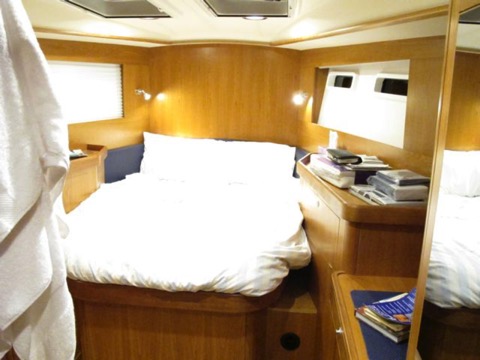
This is the forward cabin lit by 4 big downlights in the ceiling plus the two reading lights at the head of the bed. Together the 6 lights draw just about 2.5 amps. To put that in perspective that would have been just over ONE 25watt halogen. These lights are so efficient we can just turn them on at anchor whenever we want. No worries about power. The saloon was the same story. The 6 big downlights light the saloon and galley with a nice warm bright light for just 2.5 amps. This compares to the 42 (similar space but lit with halogen lights) which used over 10 amps. So we have cut the power needed to run lighting by 75% or so!
Now here’s a real surprise. While I was checking I turned on the cute mood lights Northshore have installed in all sleeping cabins. These are not LEDs, but the rope lighting often used for decorating. This used more than the main lights! In fact the shot below is actually using almost double the shot above in power but producing almost no usable light. But it does look nice...
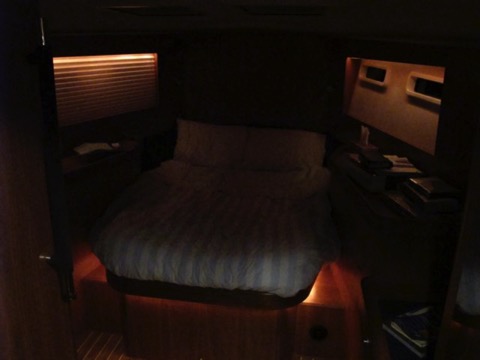
LED lighting really is here now. You can get very good looking light that will save a lot of power. And remember that saving power means you don’t need to generate and store it as well. So saving the power as we sat at anchor meant we didn’t have to replace that power the next morning. If you are planning an electrical budget you can stay with slightly smaller batteries.
Also a chance to do some real world testing with the Imtra LED lighting. WOW. We already new the lights looked great from seeing them on at the boat show in January. But now I have been able to see just how little power they use. I did tests on most of the lights at anchor. I have a few interesting pix below. Of course it is difficult to get a representative feel with the camera but I did my best. The camera must be set to all manual operation so it doesn’t adjust for dimmer lighting.

This is the forward cabin lit by 4 big downlights in the ceiling plus the two reading lights at the head of the bed. Together the 6 lights draw just about 2.5 amps. To put that in perspective that would have been just over ONE 25watt halogen. These lights are so efficient we can just turn them on at anchor whenever we want. No worries about power. The saloon was the same story. The 6 big downlights light the saloon and galley with a nice warm bright light for just 2.5 amps. This compares to the 42 (similar space but lit with halogen lights) which used over 10 amps. So we have cut the power needed to run lighting by 75% or so!
Now here’s a real surprise. While I was checking I turned on the cute mood lights Northshore have installed in all sleeping cabins. These are not LEDs, but the rope lighting often used for decorating. This used more than the main lights! In fact the shot below is actually using almost double the shot above in power but producing almost no usable light. But it does look nice...

LED lighting really is here now. You can get very good looking light that will save a lot of power. And remember that saving power means you don’t need to generate and store it as well. So saving the power as we sat at anchor meant we didn’t have to replace that power the next morning. If you are planning an electrical budget you can stay with slightly smaller batteries.
The NEW BOAT!!!
12/03/10 02:54 Filed in: Southerly Boats
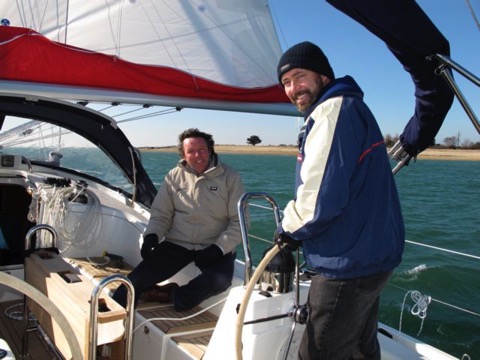
Our new Southerly 49 is in the water! We have just come down to Itchenor in the south of England and are starting the process of moving aboard and getting her ready for the sailing season ahead.
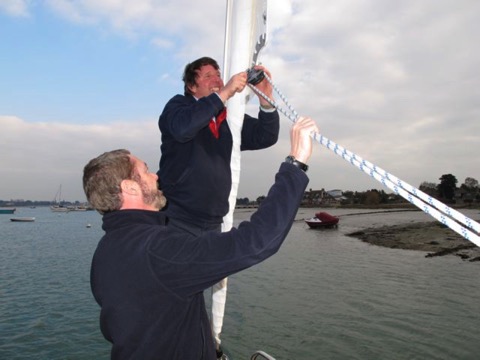
Yesterday we took her out for her first sea trial and had an exciting sail. Wind was gusting over 25 knots and it is VERY cold! Spring is about 3-4 weeks behind schedule here in England.
Initial observations are that she is very quick. The extra waterline length over the 42 obviously gives us some extra speed but she is also a fair bit finer entry. She has just 6 inches more beam but 7 feet more length. She even has slightly lower freeboard which gives her a racy look. I’ll try to get some pictures of her from the dock today.
As soon as we left the dock we put up the mainsail and she was immediately running downwind at 8 knots!
Today its raining a bit so we’ll stay below and sort things out getting familiar with the new systems. This boat has an espar heater and its wonderful and warm! I made an anchor snubber by splicing an eye into a bit of 14mm line. Then just shackle the chainhook to the splice and I can give it a test today. So many little things to get her as ready as the 42 was!
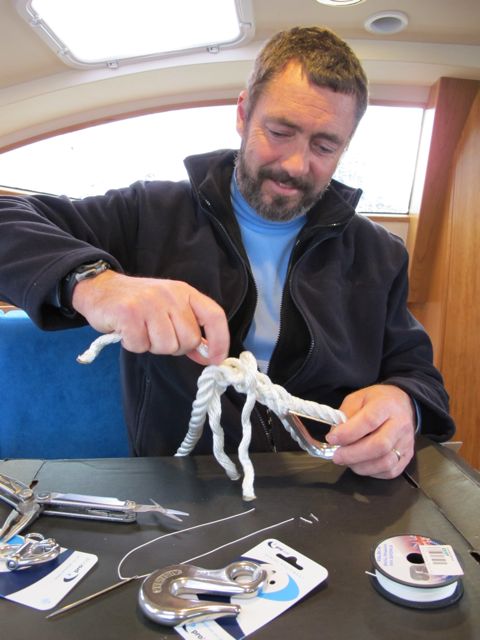
Communications 2010
07/02/10 17:05 Filed in: Communications
“How can I stay in touch” is one of the biggest concerns for cruisers heading off on a long trip. Off all the changes affecting sailors over the past 20 years this has to be one of the major ones.
With the new boat going in the water in just a few weeks I am looking for options to upgrade to the latest and greatest - mainly in the wifi and “cell phone” areas.
WIFI
We have tried a number of wifi options over the past 6 years and it has been great to be able to connect to the internet from so many places. We don’t always succeed and the challenge now is to make up the ULTIMATE wifi system. The main thing seems to be to raise the antenna up from the inside of the boat. Especially in crowded marinas it seems we were often being blocked by the hulls of nearby boats. When we put an external antenna up on deck we always got a better signal. We have tried a few external usb antennas, the latest being the waveRV marine unit we got last winter in St Martin. We never found a good place to mount the unit on Distant Shores though. I used to bring it our and prop it up under the dodger when we wanted it.
For the new Southerly 49 I would like to mount an antenna permanently on the stern-rail. I recently saw this unit made by Bitstorm that is interesting in that it is designed to connect via ethernet instead of USB. This means you can run a longer cable, and even have the antenna at the top of the mast for the ultimate range! They have a companion product that is a router so you don’t have to connect the antenna directly to the computer if you don’t want. It would also give you the option to connect multiple computers around the boat!! Oh boy has cruising changed!! ;-)
Cell Phone
The other obvious way to stay in touch is to get a decent cell phone plan. Over the past 14 years of travelling we have been experimenting and our favourite method has been to get a local GSM Sim card for the country we are cruising in. We have always been able to get a SIM card for our phone, and because we are now local we have by far the cheapest rates. It is a bit of a nuisance to be getting new numbers though. This method works best if you stay in one country for more than a few weeks. The SIM cards are not much and easily available. The important thing here is that you must have a GSM phone and it must be “unlocked” - not for use only with a specific provider.
The main thing to watch out for is roaming fees! These can mount up to crazy numbers. Friends of ours were using their phone while they travelled and got a bill after 3 months of $6,000.
I am also investigating the idea of a special roaming SIM card like this one. It might be able to give us halfway reasonable rates and would still keep the same number. We would likely still get a local SIM card when we would be in a country for a long time.
SSB
Still the best way to contact other ships on the high seas. We have the excellent Icom M802 on Distant Shores and it has been great for talking to other sailboats on the transatlantic crossing, for talking to Herb “Southbound II” for weather. And it can be used for data as well with a modem although we haven’t tried this.
Wow there is a lot of technology to keep connected. Some times though it is great just to be out in nature though. So if you can’t get a good wifi connection in paradise you can always just make up a margarita and enjoy being out in it!
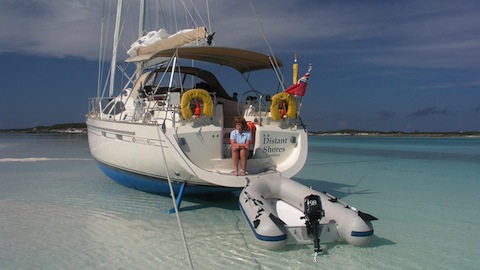
With the new boat going in the water in just a few weeks I am looking for options to upgrade to the latest and greatest - mainly in the wifi and “cell phone” areas.
WIFI
We have tried a number of wifi options over the past 6 years and it has been great to be able to connect to the internet from so many places. We don’t always succeed and the challenge now is to make up the ULTIMATE wifi system. The main thing seems to be to raise the antenna up from the inside of the boat. Especially in crowded marinas it seems we were often being blocked by the hulls of nearby boats. When we put an external antenna up on deck we always got a better signal. We have tried a few external usb antennas, the latest being the waveRV marine unit we got last winter in St Martin. We never found a good place to mount the unit on Distant Shores though. I used to bring it our and prop it up under the dodger when we wanted it.
For the new Southerly 49 I would like to mount an antenna permanently on the stern-rail. I recently saw this unit made by Bitstorm that is interesting in that it is designed to connect via ethernet instead of USB. This means you can run a longer cable, and even have the antenna at the top of the mast for the ultimate range! They have a companion product that is a router so you don’t have to connect the antenna directly to the computer if you don’t want. It would also give you the option to connect multiple computers around the boat!! Oh boy has cruising changed!! ;-)
Cell Phone
The other obvious way to stay in touch is to get a decent cell phone plan. Over the past 14 years of travelling we have been experimenting and our favourite method has been to get a local GSM Sim card for the country we are cruising in. We have always been able to get a SIM card for our phone, and because we are now local we have by far the cheapest rates. It is a bit of a nuisance to be getting new numbers though. This method works best if you stay in one country for more than a few weeks. The SIM cards are not much and easily available. The important thing here is that you must have a GSM phone and it must be “unlocked” - not for use only with a specific provider.
The main thing to watch out for is roaming fees! These can mount up to crazy numbers. Friends of ours were using their phone while they travelled and got a bill after 3 months of $6,000.
I am also investigating the idea of a special roaming SIM card like this one. It might be able to give us halfway reasonable rates and would still keep the same number. We would likely still get a local SIM card when we would be in a country for a long time.
SSB
Still the best way to contact other ships on the high seas. We have the excellent Icom M802 on Distant Shores and it has been great for talking to other sailboats on the transatlantic crossing, for talking to Herb “Southbound II” for weather. And it can be used for data as well with a modem although we haven’t tried this.
Wow there is a lot of technology to keep connected. Some times though it is great just to be out in nature though. So if you can’t get a good wifi connection in paradise you can always just make up a margarita and enjoy being out in it!

Enthusiasm for Sailing
We have finished our TWO Boat shows! London & Toronto are on over the same two weekends so we went to London for the first weekend then flew back for the last weekend of the Toronto Boat Show. Whew!
One of my favourite things about the boat shows is meeting new sailors enthusiastic about taking off on a big cruise! Sheryl and I did seminars at the Toronto show for people planning to sail south to the Bahamas and had a full house every time. Its great to see the cruising community is healthy.
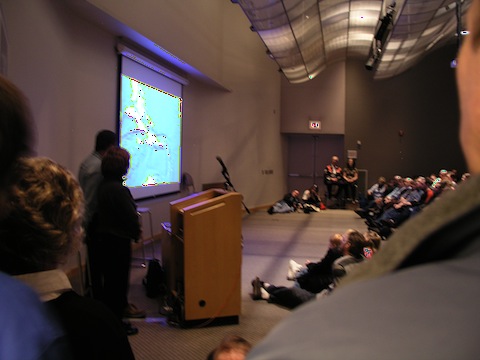
Many of these people are planning to leave this year and make their way south down the Intracoastal Waterway to the Bahamas. We showed clips from our TV series with the Erie canal, discussed the Waterway and looked at shallow water cruising in the Bahamas. Afterwards we fielded questions. Here are three of the questions we got after each seminar.
A
With the news today everyone is more concerned about piracy. But does it really affect us as sailors? Well, the answer is “it doesn’t have to”. There are certainly areas where there are pirates. But if you avoid these areas the risks are minimal. Modern pirates don’t roam the high seas like Johnny Depp. They are based from countries like Somalia where law has broken down, and restrict their operations to adjacent sea areas using small boats. So check out the cruising grapevine and find the hotspots to avoid. One excellent resource is the noonsite website piracy pages. www.noonsite.com
Budgets certainly vary from under $1000 per month for a very basic cruising style right up to whatever you want to pay. Most people find $2,000-$3,000 per month works out comfortably. Of course major repairs, expensive marina stays, flights home and the like can throw any budget off course, but in general it does not have to be an expensive lifestyle. Google search on “sail cruising budget”.
Many people in our recent seminars already have the boat they plan to take cruising. But some are still looking for their perfect cruising boat. For a trip like the intracoastal waterway there will be a bunch of motoring - so a reliable motor is important. A Bahamas winter means a fair amount of wind, but mainly short daysails, so merely renewing/upgrading/beefing up your existing rig will likely be fine. But for heading further afield, looking at ocean passages you need to ask if your boat can handle it. You will also need to be more self-sufficient and repair things along the way. This question really needs serious consideration and possibly an expert opinion or survey if you are not confident in your craft. One of the advantages of the Intracoastal Waterway Bahamas trip is that you have a few months of constant sailing and living aboard to shake out problems and find solutions when you aren’t far from help or the nearest chandlery.
It has been a GREAT 10 days of boat shows! Now we’re looking forward to seeing you out on the water!
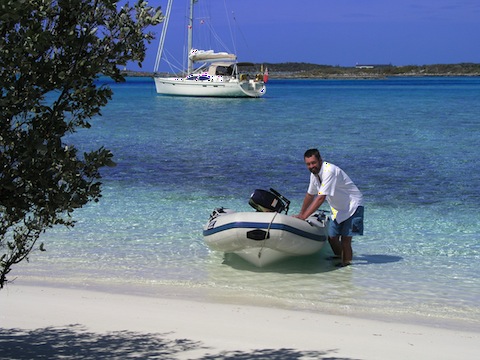
One of my favourite things about the boat shows is meeting new sailors enthusiastic about taking off on a big cruise! Sheryl and I did seminars at the Toronto show for people planning to sail south to the Bahamas and had a full house every time. Its great to see the cruising community is healthy.

Many of these people are planning to leave this year and make their way south down the Intracoastal Waterway to the Bahamas. We showed clips from our TV series with the Erie canal, discussed the Waterway and looked at shallow water cruising in the Bahamas. Afterwards we fielded questions. Here are three of the questions we got after each seminar.
A
re there Pirates?
With the news today everyone is more concerned about piracy. But does it really affect us as sailors? Well, the answer is “it doesn’t have to”. There are certainly areas where there are pirates. But if you avoid these areas the risks are minimal. Modern pirates don’t roam the high seas like Johnny Depp. They are based from countries like Somalia where law has broken down, and restrict their operations to adjacent sea areas using small boats. So check out the cruising grapevine and find the hotspots to avoid. One excellent resource is the noonsite website piracy pages. www.noonsite.com
What does it cost?
Budgets certainly vary from under $1000 per month for a very basic cruising style right up to whatever you want to pay. Most people find $2,000-$3,000 per month works out comfortably. Of course major repairs, expensive marina stays, flights home and the like can throw any budget off course, but in general it does not have to be an expensive lifestyle. Google search on “sail cruising budget”.
Can I take my boat?
Many people in our recent seminars already have the boat they plan to take cruising. But some are still looking for their perfect cruising boat. For a trip like the intracoastal waterway there will be a bunch of motoring - so a reliable motor is important. A Bahamas winter means a fair amount of wind, but mainly short daysails, so merely renewing/upgrading/beefing up your existing rig will likely be fine. But for heading further afield, looking at ocean passages you need to ask if your boat can handle it. You will also need to be more self-sufficient and repair things along the way. This question really needs serious consideration and possibly an expert opinion or survey if you are not confident in your craft. One of the advantages of the Intracoastal Waterway Bahamas trip is that you have a few months of constant sailing and living aboard to shake out problems and find solutions when you aren’t far from help or the nearest chandlery.
It has been a GREAT 10 days of boat shows! Now we’re looking forward to seeing you out on the water!

Peaking inside
14/01/10 07:44 Filed in: Southerly Boats
I shot a few pix of the interior... all wood is cherry.
This is the galley looking aft. Microwave and fridge are on the right.
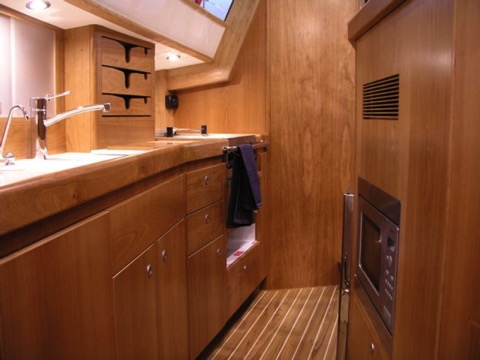
Sheryl likes the new galley! Note wineglasses... day 2 of the show one was already broken so they were put away. Sometimes it is tough at the show with so many people aboard my new pride and joy! But 99.9% of visitors are respectful and we are very proud having people on board.
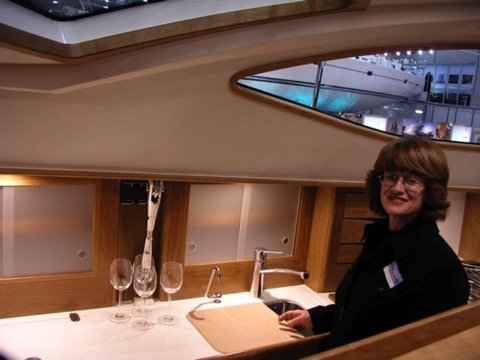
One thing cruisers always need more of is storage space... this is a separate bow locker. It is huge! Certainly room for all fenders, or spare sails. There is a ladder to climb down into it.
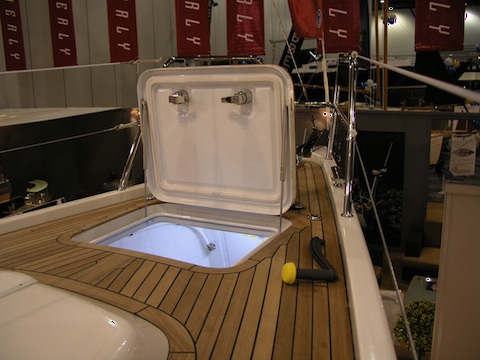
Behind me is the anchor chain locker with the door taken out.
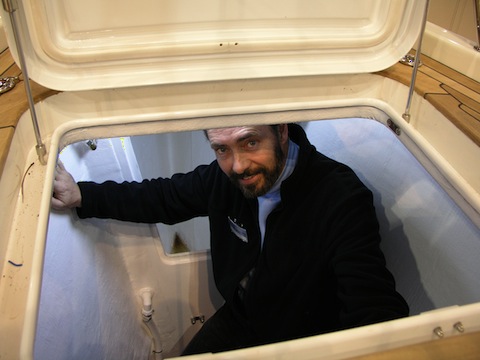
Real teak decks. Beautiful and great to walk on at sea, I had always been leery of teak decks since the screws used to hold them down were a potential leak. Not here!! No screws are used in this system. The deck is assembled together and bonded THEN the whole piece is attached to the hull by vacuum bagging!
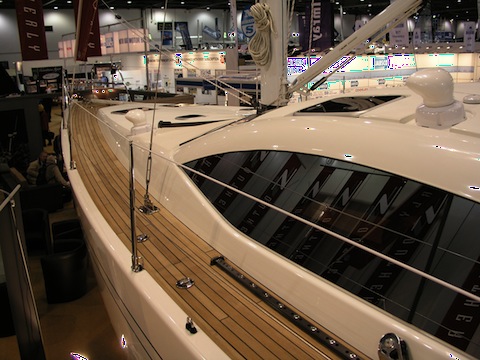
Sheryl sitting on the “Gin and Tonic” seats aft!
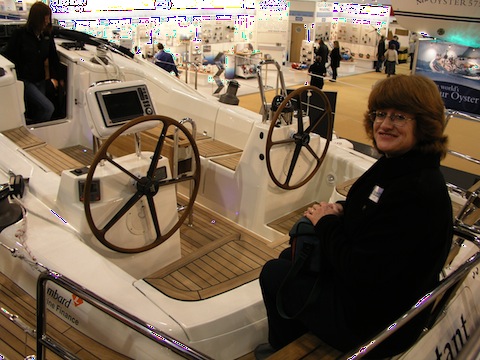
Raymarine’s new Hybridtouch plotter at the helm. Very cool! Touch screens are so convenient, but can be trouble in the rain since they think you are touching them. I had always thought they would be a problem on an outside unit. But the Raymarine units can be operated by buttons as well so you get the best of both worlds! Combined with the new Digital HD radar it will be a great package. I can’t wait to try it out on the water!!!
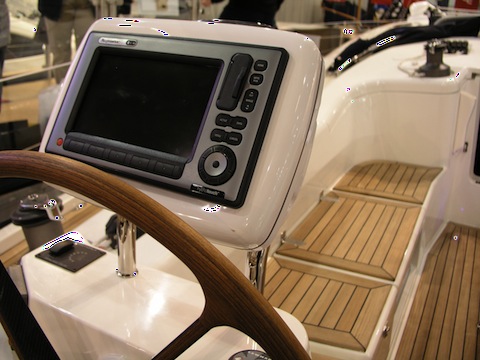
This is the galley looking aft. Microwave and fridge are on the right.

Sheryl likes the new galley! Note wineglasses... day 2 of the show one was already broken so they were put away. Sometimes it is tough at the show with so many people aboard my new pride and joy! But 99.9% of visitors are respectful and we are very proud having people on board.

One thing cruisers always need more of is storage space... this is a separate bow locker. It is huge! Certainly room for all fenders, or spare sails. There is a ladder to climb down into it.

Behind me is the anchor chain locker with the door taken out.

Real teak decks. Beautiful and great to walk on at sea, I had always been leery of teak decks since the screws used to hold them down were a potential leak. Not here!! No screws are used in this system. The deck is assembled together and bonded THEN the whole piece is attached to the hull by vacuum bagging!

Sheryl sitting on the “Gin and Tonic” seats aft!

Raymarine’s new Hybridtouch plotter at the helm. Very cool! Touch screens are so convenient, but can be trouble in the rain since they think you are touching them. I had always thought they would be a problem on an outside unit. But the Raymarine units can be operated by buttons as well so you get the best of both worlds! Combined with the new Digital HD radar it will be a great package. I can’t wait to try it out on the water!!!

At the London Boat Show
13/01/10 07:50 Filed in: Southerly Boats
London has snow this winter and the boatshow is on!
Its been 3 years since we have been to any of the winter boat shows (since we have been sailing in the Caribbean;-) and I had almost forgotten how much fun they are and how good it feels to see boats when its cold and snowy out!
In fact 3 years ago at the London Boat show we signed up to buy our first Southerly. Now three years later we return to the show and enter the main haul to see the new 49 on the stand! Gosh were we excited when we first walked into the haul and there she was!!
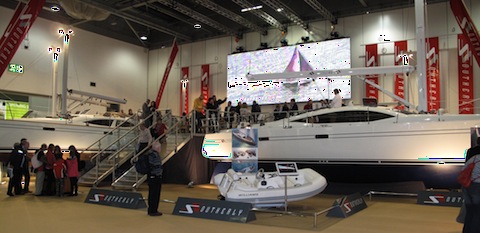
We were lucky and got to have a chat with Rob Humphreys - who designed the 49 hull - Rob and his wife are on the left. Northshore Managing Director John Warne, and Marketing Manager Claire Horsman are on the right. Thats me and Sheryl with the huge grins in the middle. We are toasting the new boat!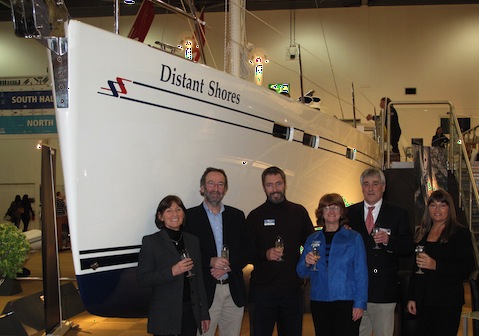
Will post more tomorrow but for now heres a couple more picture showing some of the bigger stands at the show. We were again astounded at the size and effort to display the big power boats.
Note there are people standing on the upper decks of the 86 footer in the very back! The boats are huge to be in a building!
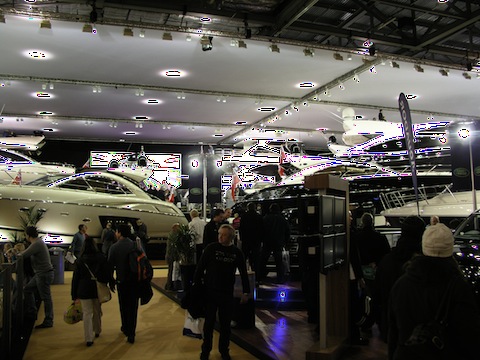
Remember this stand is all built for the show. The lower level lounge, upper viewing deck and all is constructed just for London Boat show. All built up from an empty concrete floor. Note also there is a car in the back of the powerboat!
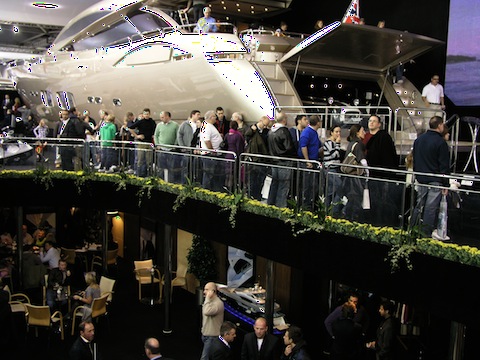
Its been 3 years since we have been to any of the winter boat shows (since we have been sailing in the Caribbean;-) and I had almost forgotten how much fun they are and how good it feels to see boats when its cold and snowy out!
In fact 3 years ago at the London Boat show we signed up to buy our first Southerly. Now three years later we return to the show and enter the main haul to see the new 49 on the stand! Gosh were we excited when we first walked into the haul and there she was!!

We were lucky and got to have a chat with Rob Humphreys - who designed the 49 hull - Rob and his wife are on the left. Northshore Managing Director John Warne, and Marketing Manager Claire Horsman are on the right. Thats me and Sheryl with the huge grins in the middle. We are toasting the new boat!

Will post more tomorrow but for now heres a couple more picture showing some of the bigger stands at the show. We were again astounded at the size and effort to display the big power boats.
Note there are people standing on the upper decks of the 86 footer in the very back! The boats are huge to be in a building!

Remember this stand is all built for the show. The lower level lounge, upper viewing deck and all is constructed just for London Boat show. All built up from an empty concrete floor. Note also there is a car in the back of the powerboat!
